
About UsThe Numismatic Bibliomania Society is a non-profit organization promoting numismatic literature. For more information please see our web site at coinbooks.org SubscriptionsThose wishing to become new E-Sylum subscribers (or wishing to Unsubscribe) can go to the following web page link MembershipThere is a membership application available on the web site Membership Application To join, print the application and return it with your check to the address printed on the application. Membership is only $20 to addresses in the U.S., $25 for First Class mail, and $30 elsewhere. For those without web access, write to: David M. Sundman, Treasurer
AsylumFor Asylum mailing address changes and other membership questions, contact David at this email address: dsundman@LittletonCoin.com SubmissionsTo submit items for publication in The E-Sylum, just Reply to this message, or write to the Editor at this address: whomren@gmail.com BUY THE BOOK BEFORE THE COIN |
- WAYNE'S WORDS: THE E-SYLUM OCTOBER 5, 2014
- SKLOW MAIL BID SALE #23 CLOSES OCTOBER 11, 2014
- KOLBE & FANNING ANNOUNCE BALTIMORE BOOK AUCTION
- NEW BOOK: 100 GREATEST U.S. COINS, 4TH ED
- NEW BOOK: EUROPEAN MEDALS IN THE CHAZEN MUSEUM
- EL SITIO NO. 12 PUBLISHED
- KOLBE & FANNING OFFER THE GOBRECHT JOURNAL
- SOME MODERN HOBO NICKELS (AND DOLLARS)
- COLUMBUS MUSEUM OF ART EXHIBITS MONEY ART
- ELEANOR RIGBY SCULPTURE MADE OF BANKNOTES
- CCAC RECOMMENDS THE U.S. MINT ISSUE ART MEDALS
- NOTES FROM E-SYLUM READERS: OCTOBER 5, 2014
- ON INDEXING NUMISMATIC LITERATURE SALES
- AUTHOR JOHN S. DAVENPORT
- BERNARD POINDESSAULT (1935-2014)
- THE RHEINISCHES LANDESMUSEUM BONN
- MORE COLONIAL SELECTIONS FROM NEWMAN PART V
- MORE ON THE JOSEPH C. MITCHELSON COLLECTION
- TRANSNISTRIA'S POLYMER COINS
- AFRICAN-AMERICAN ISSUERS OF CIVIL WAR STORE CARDS
- GADOURY DECEMBER 2014 AUCTION PREVIEW
- NUMISMATICA GENEVENSIS NOVEMBER 2014 SALE
- 1924 MILWAUKEE SPEEDSKATING MEDAL RETURNED TO FAMILY
- A VISIT TO BANKNOTE PRINTER DE LA RUE
- BALDWIN’S NUMISMATICS MOVE TO 399 STRAND
- POTLATCH COPPERS
- THE POTLATCH DOLLAR PENDANT
- 2015-2016 AMERICAN PLATINUM EAGLE REVERSE DESIGNS
- FLIGHT 93 CONGRESSIONAL GOLD MEDAL SAFE FROM FIRE
- THE SMALLEST UNITED KINGDOM COIN EVER STRUCK
- FEATURED WEB PAGE: VIETNAMESE DONG
Click here to access the complete archive
To comment or submit articles, reply to whomren@gmail.com
WAYNE'S WORDS: THE E-SYLUM OCTOBER 5, 2014

New subscribers this week include: Lee Toone, John Hart and John Ostendorf. We now have 1,777 subscribers.
This week we open with a sale reminder from David Sklow, and an announcement from Kolbe & Fanning about their upcoming Baltimore sale. Next up are two new books and one new periodical issue.
Other topics include modern Hobo nickels, money art, John Davenport, Bernard Poindessault, more great Newman colonials, African-American Issuers of Civil War Store cards, the Freestyle Medal, polymer coins, banknote printer De La Rue, and Baldwin's new offices.
To learn more about the art of the commemorative medal, the Schulman family of coin dealers, the Rheinisches Landesmuseum Bonn, the Siculo-Punic tetradrachm, Potlatch coppers and liberation dong, read on. Have a great week, everyone!
Wayne Homren
Editor, The E-Sylum
SKLOW MAIL BID SALE #23 CLOSES OCTOBER 11, 2014
 MBS # 23 closes in one short week on Saturday October 11 at
8 PM.
MBS # 23 closes in one short week on Saturday October 11 at
8 PM.
Be sure to submit your bids and do not miss your chance to bid in our largest sale to date.
Bidding is accepted via USPS, Email, Telephone & Fax, up to and including closing day. Emails and faxes received before midnight closing day will be entered, as well as bids left on our answering service.
The sale catalog is on our web site if you have misplaced your copy, it can be downloaded, or printed out. A bid sheet is also there for your convenience.
There are no changes to our terms of sale.
For more information, see:
FineNumismaticBooks.com
KOLBE & FANNING ANNOUNCE BALTIMORE BOOK AUCTION
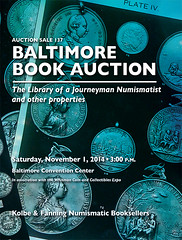 Kolbe & Fanning Numismatic Booksellers are
pleased to announce that they will be conducting a public auction of important numismatic books on
November 1, 2014 in Baltimore, Maryland. The auction will be held in conjunction with the Whitman
Coin & Collectibles Expo at the Baltimore Convention Center.
Kolbe & Fanning Numismatic Booksellers are
pleased to announce that they will be conducting a public auction of important numismatic books on
November 1, 2014 in Baltimore, Maryland. The auction will be held in conjunction with the Whitman
Coin & Collectibles Expo at the Baltimore Convention Center.
The sale features the outstanding library of a Journeyman Numismatist and other properties, and focuses on early American numismatics and closely related foreign areas. Among the highlights are:
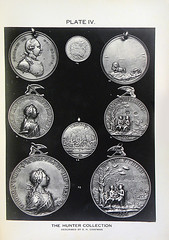 --An extraordinary 31 different plated Chapman sales,
including virtually all plated Chapman catalogues of American interest, including Bushnell, Winsor,
Morris, Stickney, Zabriskie, Jewett, Earle, Parsons, Bascom & Brown, Hunter, Jenks, Alvord,
etc.
--An extraordinary 31 different plated Chapman sales,
including virtually all plated Chapman catalogues of American interest, including Bushnell, Winsor,
Morris, Stickney, Zabriskie, Jewett, Earle, Parsons, Bascom & Brown, Hunter, Jenks, Alvord,
etc.
--No fewer than 10 plated Thomas Elder catalogues, including the 1917 and 1920 Miller sales, the
Gschwend, Mougey, McMullin, Wilson, and Lawrence catalogues, Lyman Low’s copy of the 1917 Carlton
sale, the Hewitt & Bartlett sale, and the McCoy, Brown & Ezekiel sale.
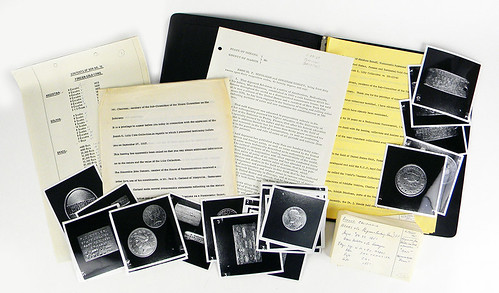
--Abe Kosoff’s hugely important archives on the Josiah Lilly collection and the controversy surrounding its acquisition by the United States as part of the National Numismatic Collection, with inventories, photographs, correspondence and other materials.
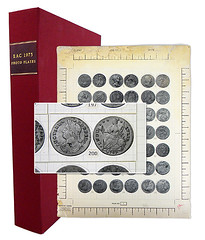 --The breathtaking original photographic paste-ups of the
plates for the 1975 EAC sale, featuring the fabled collection of Connecticut coppers formed by Q.
David Bowers as well as a sizeable offering of important large cents.
--The breathtaking original photographic paste-ups of the
plates for the 1975 EAC sale, featuring the fabled collection of Connecticut coppers formed by Q.
David Bowers as well as a sizeable offering of important large cents.
--An illustrated notebook prepared by Edgar H. Adams covering Connecticut, New York, Vermont and Confederatio coppers and the coinage of William Wood, and a second one covering Massachusetts silver and copper coins.
--George H. Clapp’s very rare suite of photographs titled Type Set of United States Cents 1793-1857.
--A first edition Crosby with both the 1873 and 1875 title pages, as well as the Maris Woodburytype plate and other special content bound in.
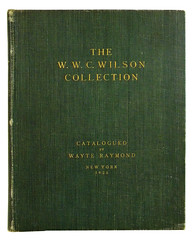 --A rare plated copy of the W.W.C. Wilson sale (Wayte
Raymond, 1925).
--A rare plated copy of the W.W.C. Wilson sale (Wayte
Raymond, 1925).
--Strobridge’s 1873 Descriptive Catalogue of the Seavey Collection of American Coins.
The sale includes many other notable works, most especially on American colonial coins, featuring early plated sales and standard works as well as rarely offered photographic plates depicting specialized series. A number of items are unique, and many others are rarely encountered.
Printed catalogues are being mailed to established clients. A PDF of the catalogue has been posted to the Kolbe & Fanning website. Prospective bidders may also access the live online catalogue and register to bid through the main website at www.numislit.com.
The sale will begin at 3:00 pm in Room 306 of the Baltimore Convention Center on November 1. Lot viewing will be held on Thursday and Friday October 30 and 31 from 9:00 am to 5:00 pm and on the day of the sale from 9:00 am till 12:00 noon.
Absentee bids will be accepted via post, phone, email and fax (deadlines will be announced later). Live online bidding will be available through Kolbe & Fanning’s online auction portal at auction.numislit.com (managed through iCollector). Bidders planning to participate in the sale online are strongly encouraged to register in advance.
Kolbe & Fanning Numismatic Booksellers LLC is a licensed auction firm in the State of Ohio and is conducting the sale in conjunction with Jonathan Melnick Auctioneers, Inc., of Baltimore, Maryland. For more information, please see the Kolbe & Fanning website at www.numislit.com or email David Fanning at df@numislit.com. We look forward to your participation.
THE BOOK BAZARRE
NEW BOOK: 100 GREATEST U.S. COINS, 4TH ED
 New Whitman Book Explores the 100 Greatest U.S.
Coins of All Time
New Whitman Book Explores the 100 Greatest U.S.
Coins of All Time
Whitman Publishing announces the release of the fourth edition of the award-winning 100 Greatest U.S. Coins. The hardcover coffee-table book will be available October 25, 2014. Before then it can be pre-ordered online (including at WhitmanBooks.com) and from booksellers and hobby shops nationwide for $29.95. It can also be borrowed for free from the Dwight N. Manley Numismatic Library as a benefit of membership in the American Numismatic Association (www.money.org).
In this beautifully illustrated book, numismatist Jeff Garrett, with fellow researcher Ron Guth, takes the reader on a guided tour of the American coins that have captured the imagination of generations of collectors. In the introduction Garrett asks the question “What makes a coin great?” His analysis explores factors such as rarity, value, quality, popularity, beauty, and history.
The introduction of the fourth edition has been expanded with more full-color illustrations and text describing the history of United States coinage, ways to collect U.S. coins, grading standards, determining values, and other facets of the hobby.
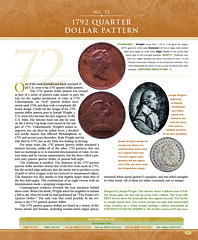 In the foreword, Mark Salzberg, chairman of
Numismatic Guaranty Corporation, notes that even though the 100 Greatest U.S. Coins are valuable,
they’re undervalued in the broader context of rare collectibles. “The 250 highest prices paid for
U.S. coins at auction total just less than $250 million in value,” he writes. “In context, that is
a bit less than the sales price of the most valuable painting ever sold, Paul Cezanne’s The Card
Players.” Kenneth Bressett, longtime senior editor of the Guide Book of United States
Coins, writes, “Not all of the 100 Greatest U.S. Coins are unique specimens confined to one
collection. A lucky numismatist could potentially find a 1955 Doubled Die Obverse Lincoln cent in
their pocket.”
In the foreword, Mark Salzberg, chairman of
Numismatic Guaranty Corporation, notes that even though the 100 Greatest U.S. Coins are valuable,
they’re undervalued in the broader context of rare collectibles. “The 250 highest prices paid for
U.S. coins at auction total just less than $250 million in value,” he writes. “In context, that is
a bit less than the sales price of the most valuable painting ever sold, Paul Cezanne’s The Card
Players.” Kenneth Bressett, longtime senior editor of the Guide Book of United States
Coins, writes, “Not all of the 100 Greatest U.S. Coins are unique specimens confined to one
collection. A lucky numismatist could potentially find a 1955 Doubled Die Obverse Lincoln cent in
their pocket.”
The 100 Greatest U.S. Coins were voted on and ranked by members of the Professional Numismatists Guild. In the fourth edition, the celebrated 1804 silver dollar rose to the No. 1 spot (up from No. 5, and displacing the 1913 Liberty Head nickel at the top of the rankings). The unique 1851 Liberty Seated dollar struck over a New Orleans dollar dropped entirely from the list, and the 1974 aluminum Lincoln cent made its debut, at No. 88.
100 Greatest U.S. Coins, fourth edition, also includes illustrated biographies of the “Great Collectors of the Past,” from Harry Bass to William Woodin; a price history of the 100 Greatest, from 1960 to date; a chart of the top 200 U.S. coin prices realized at auction from 1990 to 2014; a breakdown of the 100 Greatest by denomination and coin type; a glossary; a bibliography for further research; and a detailed index. The book is coffee-table-size, 144 pages, in full color, with photographs and stories for every coin. It also includes historical photographs, market values, field populations, certified-coin census reports, quantities minted, specifications, and coin design notes.
100 Greatest U.S. Coins, fourth edition
By Jeff Garrett, with Ron Guth; foreword by Mark Salzberg
ISBN 0794842755; hardcover, coffee-table (10 x 12 inches); 144 pages; full color; retail $29.95
U.S.
To read the complete article, see:
https://www.whitman.com/store/Inventory/Detail/The-100-Greatest-Coins-4th-Edition+0794842755
NEW BOOK: EUROPEAN MEDALS IN THE CHAZEN MUSEUM
 European Medals in the Chazen Museum of
Art
European Medals in the Chazen Museum of
Art
Highlights from the Vernon Hall Collection and Later Acquisitions
Introductory Essay by Stephen K. Scher
Contributors: Philip Attwood, Arne R. Flaten, Mark Jones, Douglas Lewis, Eleonora Luciano, Joseph
G. Reinis, Stephen K. Scher, Jeffrey Chipps Smith, Louis A. Waldman
Edited by Maria F.P. Saffiotti Dale
Softcover, illus. 28 B&W, 124 color
205 pages
$39.95, plus postage
ISBN: 978-1-93327-017-3
This grouping of medals represents the museum’s Renaissance, Baroque, and nineteenth-century highlights and illustrates the history of the art of the commemorative medal. This catalogue incorporates the scholarship of nine international medallic experts. Their erudition, consummate research skills, and effective prose are evident in sixty-one essays on some of the masterpieces of this art form written for the education and enjoyment of students, specialists, and the general public alike.
Here is a summary of the collection from the Director's Foreword:
"While the medals range from the fifteenth to the twentieth centuries, examples from the Renaissance and Baroque periods constitute the strength of the museum’s holdings. Of exceptional quality and rarity are five contemporaneous casts of Italian fifteenth-century medals, four by the painter and medalist Pisanello and one by Matteo de’Pasti. Other important Italian Renaissance medals include contemporaneous or early casts by Amadio da Milano, Giulio della Torre, and Andrea Cambi, called Bombarda. The Hall collection also includes important holdings in sixteenth- and seventeenth-century French medals, notable among which are the portrait medals of Louis XII and Anne de Bretagne by Nicolas Leclerc and Jean de Saint-Priest, as well as several major casts by Guillaume Dupré depicting the French kings Henry IV and Louis XIII. In addition, the collection possesses some fine examples of German and Netherlandish portrait medals, particularly those by Hans Reinhart the Elder and Coenraad Bloc."
In addition to an introductory essay by Stephen K. Scher, "The Development of the Commemorative Medal: The Fifteenth to the Nineteenth Centuries," and 61 entries with medallists' biographies authored by nine experts in the field, this catalogue includes an extensive bibliography, an index of legends, and a general index. An illustrated Handlist of the remaining 240 medals in the Vernon Hall Collection with accompanying Concordances (which will allow the reader to correlate Chazen Museum accession numbers, the 1978 Hall catalogue numbers, and the new catalogue numbers for all 302 medals) will be published in digital format in the future and will be accessible through the museum's website.
Contributors inclide:
Philip Attwood, Keeper of the Department of Coins and Medals at The British Museum, is the author of Italian Medals c. 1530–1600 in British Public Collections.
Arne R. Flaten, Professor of Art History and Chair of Visual Arts at Coastal Carolina University, is author of Medals and Plaquettes in the Ulrich Middeldorf Collection at the Indiana University Art Museum 15th to 20th Centuries.
Mark Jones was Director of the Victoria and Albert Museum from 2001 to 2011 and as Curator in the Department of Coins and Medals at The British Museum authored A Catalogue of the French Medals in the British Museum.
Douglas Lewis was Curator of Sculpture and Decorative Arts at the National Gallery of Art for thirty-six years before his retirement in 2004 and has written extensively on Italian Renaissance and Baroque medals and plaquettes.
Eleonora Luciano is Associate Curator of Sculpture and Decorative Arts at the National Gallery of Art, where she contributed to the Systematic Catalogue of Renaissance Medals and has published on Italian Renaissance sculpture.
Joseph G. Reinis, Associate Curator, The Mossman Lock Collection, scholar, collector, and writer on nineteenth-century sculpture, is the author of the definitive catalogue raisonné The Portrait Medallions of David d’Angers.
Stephen K. Scher, medallic scholar and collector, curated the 1994 exhibition The Currency of Fame: Portrait Medals of the Renaissance at The Frick Collection and at the National Gallery of Art, and has edited and contributed to its accompanying catalogue.
Jeffrey Chipps Smith, Kay Fortson Chair in European Art in the Department of Art and Art History at the University of Texas at Austin, has published widely on German Renaissance art.
Louis A. Waldman, Associate Professor in the Department of Art and Art History at the University of Texas at Austin, has written extensively on Italian fifteenth- and sixteenth-century painting and sculpture.
Maria adds:
I hope this gives you and your readers enough information to whet your appetites to purchase this publication and to recommend it to fellow medals collectors, scholars, and enthusiasts. With a the print run of 500 copies, I encourage your readers to order the book online as soon as possible at the Chazen Museum Shop website.
The Chazen's permanent collection is searchable online through the museum website. Of particular interest to medals collectors are two notable collections: The Vernon Hall Collection, and The Andrew Laurie Stangel Collection of mostly German medals from Bismark to WWII, as well as papal medals.
For more information, or to order, see: http://www.chazen.wisc.edu/product/european-medals-in-the-chazen-museum-of-art
To view the museum collections, see:
http://www.chazen.wisc.edu/explore-art/collections/.
To view the Vernon Hall Collection, see:
Vernon
Hall Collection (embarkkiosk.chazen.wisc.edu/PRT526?sid=13871&x=296638&x=296639)
To view the Andrew Laurie Stangel Collection, see:
Andrew
Laurie Stangel Collection
(embarkkiosk.chazen.wisc.edu/PRT528?sid=13871&x=296654&x=296655)
EL SITIO NO. 12 PUBLISHED
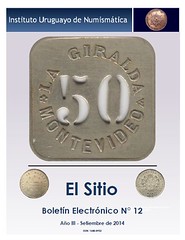 El Sitio” N° 12 contains, in its 24 pages, four numismatic
articles, a note on the celebrations of the 59 years of the Instituto Uruguayo de Numismática and a
chronicle about a conference on the Tammaro House, an old medal and tokens mint situated in the
Ciudad Vieja of Montevideo city.
El Sitio” N° 12 contains, in its 24 pages, four numismatic
articles, a note on the celebrations of the 59 years of the Instituto Uruguayo de Numismática and a
chronicle about a conference on the Tammaro House, an old medal and tokens mint situated in the
Ciudad Vieja of Montevideo city.
The cover of “El Sitio” N° 12 shows the picture of the obverse of a 50 centésimos La Giralda token, made in Paris by Francis Cartaux. La Giralda was a famous bar (confitería) in Montevideo at the beginning of the XXth century.
The four published articles are the following:
1) Francis Cartaux, graver and maker of the La Giralda token, by Horacio Morero Ferrero.
2) Schulman, Synonymous for Numismatic, by Javier Avilleira.
3) The special sets of the First Exposition of the Instituto Uruguayo de Numismática in 1957, by Diego Artigalás.
4) New variety in the 1828 4 soles of La Rioja, by Horacio Morero.
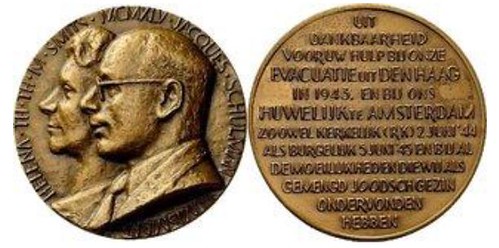
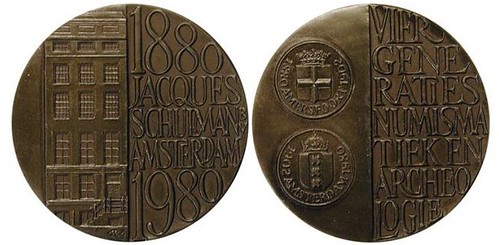
To read the complete issue, see:
www.iunuy.org/designroom00/wp-content/uploads/2014/03/ElSitioN%C2%BA12.pdf
KOLBE & FANNING OFFER THE GOBRECHT JOURNAL
 Kolbe & Fanning are proud to announce
that they are now the exclusive distributors of The Gobrecht Journal Collective Volumes.
Kolbe & Fanning are proud to announce
that they are now the exclusive distributors of The Gobrecht Journal Collective Volumes.
Published by the Liberty Seated Collectors Club since 1974, The Gobrecht Journal is an invaluable source of information on the Liberty Seated coinages. The Collective Volumes ensure that articles published in individual issues are preserved for future generations of collectors who may not have the original issues. Volumes One through Five, comprising the first 78 issues, are available for individual sale or for purchase as a complete set through our online bookstore at numislit.com

SOME MODERN HOBO NICKELS (AND DOLLARS)
Larry writes:
These are getting attention & prices, but is it a “love token” or a true Hobo nickel? Work of Art!
His Only Friend
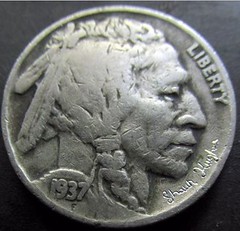
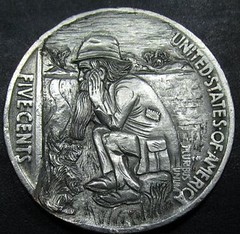
To read the complete eBay description, see:
'His Only Friend'Hobo Nickel Carving by Shaun Hughes
(www.ebay.com/itm/039-His-Only-Friend-039-Hobo-Nickel-Carving-by-Shaun-Hughes-/121441362353)
Just A Shell Of A Hobo

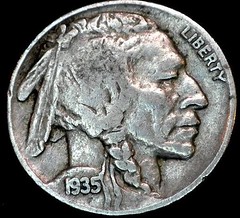
To read the complete eBay description, see:
Hobo Nickel "Just A Shell Of A Hobo" Turtle Reverse by Howard Thomas
(www.ebay.com/itm/Hobo-Nickel-Just-A-Shell-Of-A-Hobo-Turtle-Reverse-by-Howard-Thomas-/201177162299)
Low Hanging Moon
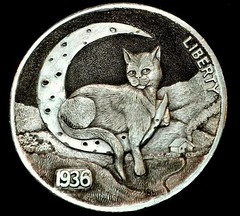
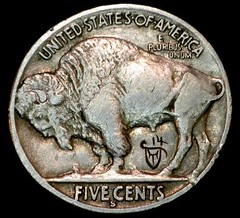
Larry writes:
Where is the basic Indian? Notice the “trademark”?
To read the complete eBay description, see:
Hobo
Nickel "Low Hanging Moon" Cat Kitten by Howard Thomas
(www.ebay.com/itm/Hobo-Nickel-Low-Hanging-Moon-Cat-Kitten-by-Howard-Thomas-/201176444928)
Skull & Buffalo Skeleton
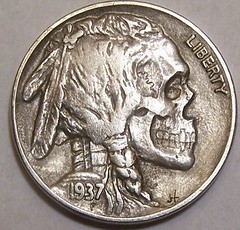
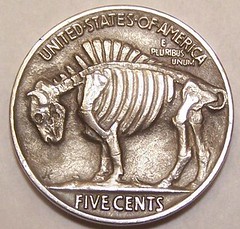
To read the complete eBay description, see:
2-Sided HOBO NICKEL Western Indian HUMAN SKULL
& BUFFALO SKELETON John Hughey JH (www.ebay.com/itm/-/261616672056)
Old Time Numismatist

To read the complete eBay description, see:
1887 Morgan Hobo Nickel Dollar Carving "Old Time Numismatist" 24k Gold Inlay!
(www.ebay.com/itm/1887-Morgan-Hobo-Nickel-Dollar-Carving-Old-Time-Numismatist-24k-Gold-Inlay-/111373360781)
COLUMBUS MUSEUM OF ART EXHIBITS MONEY ART

The Columbus Museum of Art presents In __ We Trust: Art and Money from October 3, 2014 to March 1, 2015. In __ We Trust is a group show featuring 26 artists and collectives from diverse international backgrounds whose work addresses the nature of money and its complex relationship to art. The exhibition presents works that use currency as a material or subject, involve transactions, precious materials, alternative forms of exchange, and explore aspects of the financial economy. Anchored by select pieces from previous decades, the exhibition focuses on work made since the 2008 financial crisis.
Artists include JSG Boggs, Sarah Cain, Susan Collis, Moyra Davey, e-flux Time/Bank, Claire Fontaine, Tom Friedman, Meshac Gaba, Ryan Gander, Ori Gersht, Roger Hiorns, William E. Jones, Komar and Melamid, Gabriel Kuri, Caleb Larsen, Shane Mecklenburger, Cildo Meireles, Ester Partegas, Paul Ramirez Jonas, Hugh Scott-Douglas, Reena Spaulings, Superflex, Mark Wagner, Nari Ward, Andy Warhol and Robert Wechsler. Money is a simple fact of everyday life, as well as fundamental to our social, political and economic order. Together, these artists explore issues of representation, value and exchange that have both personal and global impact.
The Museum has an important focus on art that explores social issues, and money has a more central place in our society, and our art, than ever before, said CMA Executive Director Nannette Maciejunes. This show helps us consider the values, symbols and relationships that circulate along with our money.
In __ We Trust: Art and Money is CMAs first major thematic exhibition organized by Tyler Cann, the Museums associate curator of contemporary art. Although we tend to think of money as inherently valuable, its value is a convention that depends on collective states of mind like trust and confidence, Cann says Like money, art requires some shared belief in its potential to hold meaning.
To read the complete article, see:
Columbus Museum of Art Presents In __
We Trust: Art and Money (www.columbusmuseum.org/about-cma/news-room/)
ELEANOR RIGBY SCULPTURE MADE OF BANKNOTES
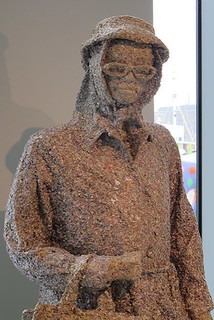 The Museum of Liverpool is to display a sculpture of one
of the city’s most well-known characters, made famous by the Beatles song bearing her name, Eleanor
Rigby.
The Museum of Liverpool is to display a sculpture of one
of the city’s most well-known characters, made famous by the Beatles song bearing her name, Eleanor
Rigby.
Created by Liverpool-born artist and sculptor Leonard J Brown, the 5ft 2 inch sculpture has been crafted out of £1million worth of old bank notes; a stark contrast when compared to the ‘bag lady’ who inspired the work, and died without a penny to her name.
Just as the lyrics go - ‘all the lonely people’ - Leonard’s juxtaposition of the poverty-stricken Eleanor Rigby and her rebirth using old money, demonstrates the relationship between wealth and poverty, which Leonard hopes will pass on a positive message to visitors.
A note accompanying the sculpture says ‘I cried because I had no shoes, until I saw a man who had no feet’, a saying which Leonard was often reminded of as a youngster growing up in Liverpool and believes is particularly poignant and still relevant today.
Leonard said: “The sculpture serves to show people that money isn’t the only way to make you happy, or indeed ‘buy you love’ and we should all be thankful for what we have. There are people in every town and city like Eleanor Rigby who live a lonely life, and whose only worldly goods are kept in the bags that they carry.”
Born in New Henderson Street off Park Road in Liverpool in the 1940s, Leonard recalls Post-War Liverpool Waterfront as a derelict area following heavy bombing of the city. As a child he and his friends spent their time playing in the area, running in and out of dock buildings and across the Hartley Bridge, which joins Mann Island and the Albert Dock next to the Museum of Liverpool.
Leonard continues: “To have this sculpture on display here in my home city, and on the site of the place I used to play as a young boy, is absolutely phenomenal and a dream come true. I left the city in 1966 to pursue a career as a singer in the Channel Islands, but I still have the accent and will always be a proud Liverpudlian.”
In order to get the high quantity of bank notes he needed to create his Eleanor Rigby sculpture, Leonard had to go straight to the top and started off trying to contact the Governor of the Bank of England to grant his request for £1million bank notes.
After months of discussion, he was invited to London to pick up the notes, which were given to him in the form of shredded pellets. £300,000 worth of the notes make up some of the materials that fill the chest cavity, and the rest of the pellets were then mashed and moulded over a steel frame bound in wire, to create the figure.
Leonard was inspired to create the sculpture after seeing an old lady – much like Eleanor Rigby - carrying a large number of bags through the centre of Hull where he now lives. The sight touched him and stirred his imagination of where she might have been going and what she struggles she might be facing.
The sculpture took six months to complete and was finished in August 2013. It will be displayed in the Atrium of the Museum of Liverpool until January 2015.
To read the complete article, see:
Eleanor Rigby sculpture goes on display at Museum of Liverpool
(artdaily.com/news/73343/Eleanor-Rigby-sculpture-goes-on-display-at-Museum-of-Liverpool#.VDEkMfmzFYE)
THE BOOK BAZARRE
CCAC RECOMMENDS THE U.S. MINT ISSUE ART MEDALS
To their credit the Citizens Coinage Advisory Committee (CCAC) is calling for the U.S. Treasury to issue two annual art medals. One, emblematic of Liberty and issued in a uniform series, would change only one side each year.
The other would be a Freestyle Art Medal allowing the artist to choose not only the subject but also a style to best present that theme. It is anticipated a medallic creation would be chosen by a new artist each year.
While the topic of issuing art medals struck by the U,S, Mint has long been discussed by the Committee, this is the first time the proposal has reached a full recommendation to the Treasury.
The Committee has substantial credentials for making such recommendation. Five numismatists have been members of the Committee during these discussions, including Michael Moran, Arthur Houghton, Roger Burdette and Robert Hoge.
Authorities from the medallic field include Heidi Wastweet and Jeanne Stevens-Sollman. Donald Scarinci, now in his second term, falls in both categories having collected U.S. Colonial coins and, within the last decade, has built the world's largest private art medal collection.
The recommendation suggests the size for each medal: 2-inch (40.6mm) for the annual Liberty series medal, and 3-inch (76.2mm) or thereabouts for the Freestyle Medal.
The Liberty Medal would contain one ounce of .999 fine silver, and the Freestyle Medal issued in both silver and bronze.
It is hoped the Mint resists the temptation to strike the Liberty Medal on a coining press, which it could easily do because of the size. As such it would fall within the bullion medal category and negate any art medal appeal, The design and model is hoped to be of such high relief it would be required to be struck on a medal press.
As for the Freestyle Medal its appeal will depend upon two things -- the reputation of the artist and the design of the image. The invitation for such a medal should attract only seasoned medallists. This should not be a training ground for wannabe medallists.
Unfortunately the initial submission of the design ideas must be as drawings. (I say unfortunately because exceptional art medal designs often cannot be expressed adequately as 2-dimensional drawings, they must be viewed as reliefs.)
From these entries however, a handful of designs would be selected and the artists must then furnish oversize bas-relief models. It is hoped the selection would be made by artists knowledgeable in medallic art and not government bureaucrats.
Final selection would be made from these entries. No payment would be made to artists submitting drawings, payments should be made to compensate all artists submitting models, with a substantial amount to the artist creating the final selection.
Production of the dies is another important aspect. Current attitude at the Mint is to make all reductions by computer engraving technology, as the Mint has mothballed all their Janvier reducing machines. Art medals require the delicate, realistic, finite execution of die-cutting best accomplished on Janvier or similar machines from metal patterns. ("If it's in the model, it's in the medal.")
Computer engraving, while satisfactory for most die-cutting and exhibits great savings in time, the images it produces are somewhat more plastic, less detailed in comparison to the life-like, finite realism which can be obtained by earlier established technology.
We welcome the Mint's return to art medal issuing. Previously it was phased out in the 1980s when all medal inventories were sold off -- some indignantly sold in grab-bags -- and no new medals issued, other than what was demanded by Congress.
The Treasury should not expect large sales of art medals, at least not like some of the coin issues they have come to experience recently. But issuing such art medals every year they are supporting a vital art media in America. They will earn a profit from coin issues; they will earn a reputation from art medal issuing.
We welcome this proposal.
Paul Gilkes wrote an article for Coin World about the CCAC recommendation at: www.coinworld.com/insights/ccac-adopts-resolution-for-annual-art-medals-from-u--s--mint.html
David Harper, editor of Numismatic News is conducting a poll, asking for comments and if you would purchase such art medals. He can be reached at: David.Harper@fwpubs.com
NOTES FROM E-SYLUM READERS: OCTOBER 5, 2014
Query: 1794 Starred Reverse Cent Photos Sought
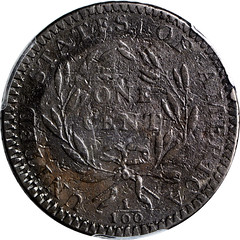 Dave Bowers writes:
Dave Bowers writes:
Does anyone have sharp photographs of the following coin as described in U.S. Patterns? I am reactivating a project of about 30 years ago in comparing the stars with those on the 1794 cent, S-48 starred reverse. At one time I had thought of writing a book on this coin. Photograph of an S-48 reverse attached.
Two Dollar Bills Make a Statement
Jan Monroe writes:
The story on stickered coins reminded me of the time I was president of a pool league in Newport Oregon around 1980 and gave out the league winnings in two dollar bills. I am sure everyone complained but it got the attention of the merchants and banks that the league had an effect on the economy.
To read the earlier E-Sylum articles, see:
COAL DOLLARS
(www.coinbooks.org/esylum_v17n40a20.html) MORE STICKERED COINS
(www.coinbooks.org/esylum_v17n40a21.html)
50 Years of Coins in Lucite
Fred Schwan writes:
The delicious diversity of numismatics and astonishing ability of The E-Sylum to cover it is demonstrated by the story on coins in Lucite that generated a letter and now a second. On reading the letter, I remembered the time in 1964 with a rather new driver's license I made my first solo overnight trip to Detroit. In addition to my official task, I visited coin shops. At one I purchased a current set of coins in a Lucite cube. I just went to the living room where the cube is on the coffee table. I thought that it held a proof set, but it is simply an uncirculated set of 1964 coins. I have been carrying it around for 50 years. Thank you for the trip down memory lane.
To read the earlier E-Sylum articles, see:
COIN-FILLED LUCITE TOILET SEAT
(www.coinbooks.org/esylum_v17n39a33.html)
NOTES FROM E-SYLUM READERS: SEPTEMBER 28,
2014 : More on Numismatic Toilet Seats (www.coinbooks.org/esylum_v17n40a11.html)
October PAN Show Lecture Series
Rich Jewell writes:
I see where Pat McBride sent you some information regarding the PAN Banquet and our guest speaker, Bob Evans, Friday night, October 24th but we also have the Lecture Series Speakers for that same afternoon starting at 12:00PM:
12:00PM- Simcha Kuritsky-"Israel's Innovative Designs that Avoid Graven Images"
1:00PM- Bill Bugert- "Martin Luther Beistle-Numismatist Extraordinaire"
2:00PM- E. Tomlinson Fort-"The Mints of the Aquitaine during the Reign of Charles the Bald: 840-877 AD"
3:00PM- Bob Evans-"S.S. America: An Update (2014)"
It promises to be a very educational and interesting Friday afternoon at the Lecture Series.
For more show information, see:
http://pancoins.org/
To read the earlier E-Sylum article, see:
BOB EVANS TO SPEAK AT OCTOBER 2014 PAN
SHOW (www.coinbooks.org/esylum_v17n40a07.html)
The Wall Street Collectors Bourse
Regarding the Museum of American Finance, Paul Bosco writes:
There will be a "coin" show, the Wall Street Bourse, October 23-25, 2014 at the Museum. Museum admission is free during the show. As you'd expect, there will be stocks & bonds, as well as numismatic stuff.
For more information on the show, see:
http://wallstreetbourse.com/
To read the earlier E-Sylum article, see:
THE MUSEUM OF AMERICAN FINANCE
(www.coinbooks.org/esylum_v17n40a19.html)
Postage Stamp Printing Plates
Web site visitor Greg Ruble writes:
I have a query concerning a copper plate I picked up over 20 years ago that I’m hoping you can solve for me.
I was in a coin shop in Ohio one day going through a basket of old coins when I came upon the following: A copper intaglio printing plate of the John F. Kennedy 5 cent postage stamp, the one showing the eternal flame. It has a an extensive (what looks like) Federal I.D. Number engraved on its back.
My question is: “How did an intaglio printing plate of the 5 cent JFK postage stamp get into a coin basket in a coin shop in Ohio?” Doesn’t the Postmaster General have the plates destroyed when the stamp is no longer being printed? Are there collectors of these printing plates?
Medals By Anna Coleman Ladd
Paul Bosco writes:
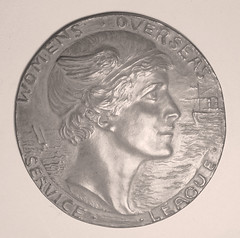 The Anna Coleman Ladd piece pictured last
week, about Serbia in WW1, likely a piece given for contributions? I have had this –perhaps still
do—but small, maybe nickel-size. If I recall it was wearable (looped).
The Anna Coleman Ladd piece pictured last
week, about Serbia in WW1, likely a piece given for contributions? I have had this –perhaps still
do—but small, maybe nickel-size. If I recall it was wearable (looped).
This piece (shown at right - Editor) is uniface. The patina is green, very possibly a reference to the sea.
To read the earlier E-Sylum article, see:
SCULPTOR ANNA COLEMAN LADD
(www.coinbooks.org/esylum_v17n40a22.html)
Vicken Yegparian on the 1804 Dollar
Len Augsburger writes:
Vicken Yegparian made it onto CNN (re 1804 dollar).
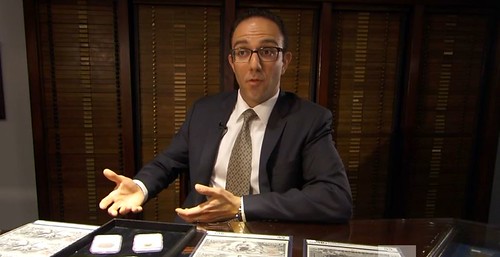
To view the video, see:
This dollar is actually worth $2 million
(money.cnn.com/video/luxury/2014/10/01/this-dollar-coin-is-actually-worth-two-million-dollars.cnnmoney/index.html)
ON INDEXING NUMISMATIC LITERATURE SALES
Fred Lake writes:
As a starting point for Jeff Dickerson, he might begin by listing all of the numismatic literature dealers and their sales. Martin Gengerke’s eighth edition of American Auction Sales shows the sales of Function Associates (Lake Books), Charles Davis, George Kolbe, Money Tree, David Sklow, etc. with number of lots for each sale. This gives a starting point of many hundreds of thousands of strictly numismatic literature auctions so the task is a daunting one that Jeff is proposing.
To read the earlier E-Sylum article, see:
QUERY: NUMISMATIC LITERATURE SALE
INDEX (www.coinbooks.org/esylum_v17n40a05.html)
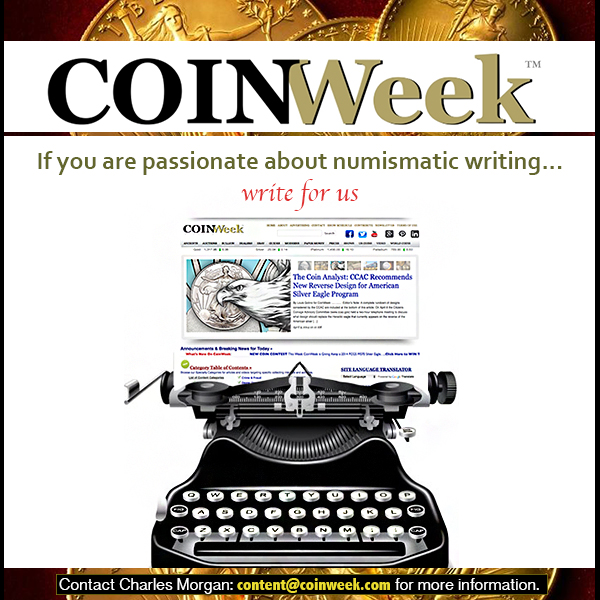
AUTHOR JOHN S. DAVENPORT
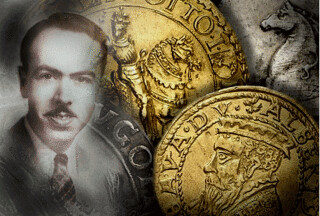 Rarely does a single individual become identified so
completely with any area of numismatics as did Dr. John S. Davenport (1907-2001). Over a period of
more than 50 years, his name became synonymous with the world of large-size silver coins, generally
referred to as crowns and talers.
Rarely does a single individual become identified so
completely with any area of numismatics as did Dr. John S. Davenport (1907-2001). Over a period of
more than 50 years, his name became synonymous with the world of large-size silver coins, generally
referred to as crowns and talers.
An educator of note with a distinguished career as professor of English literature, Davenport was born in Buffalo, N.Y. He received his Bachelor’s degree from Cornell in 1928; his Master’s from Harvard the following year and completed his Doctorate at North Carolina in 1934. Most of his teaching career was spent at Knox College in Galesburg, IL.
Davenport began collecting coins in 1921 and carried on until his death 80 years later. Collecting of what were then called “foreign coins” was then in its infancy in the U.S. No comprehensive or specialized catalogs were available, but crowns and talers were a natural as a distinct collecting area.
German numismatists had published multi-volume taler catalogs in the 1700’s, which are sometimes still cited today, but such historic references as Madai and Schulthess-Rechberg were already major rarities in their own right in the 1920’s. There were no such pioneer volumes of world crowns, so the frustrated Davenport soon set out to create them.
Some of Davenport’s first cataloging appeared as articles in the American Numismatic Association’s journal The Numismatist and in Lee F. Hewitt’s Numismatic Scrapbook Magazine during the 1940’s. He found it possible to begin explorations of such clearly defined series as crowns of Swiss Cantons and cities during World War II, when paper shortages made publishing new books nearly impossible.
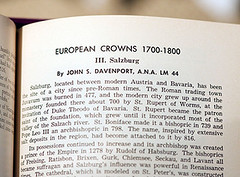 The first volume in a series of nine of similar size
and format appeared in 1947, European Crowns since 1800, bearing the imprint of Foster &
Stewart, Buffalo, N.Y. Within its 9¼ x 6½-inch purple-pebbled hard covers were 194 pages covering
coins from Albania through Yugoslavia, plus appendices providing translations of hundreds of coin
inscriptions and a detailed bibliography.
The first volume in a series of nine of similar size
and format appeared in 1947, European Crowns since 1800, bearing the imprint of Foster &
Stewart, Buffalo, N.Y. Within its 9¼ x 6½-inch purple-pebbled hard covers were 194 pages covering
coins from Albania through Yugoslavia, plus appendices providing translations of hundreds of coin
inscriptions and a detailed bibliography.
Though generally seen as separate volumes, Davenport looked upon his crown and taler books as a continuous record, ultimately assigning “Davenport numbers” to talers (1 through 10,063) and crowns (1 through 8,899).
To read the complete article, see:
A Crown and Taler Man, Reflections on Dr. John S. Davenport
(www.coinweek.com/education/numismatic-history/crown-taler-man-reflections-dr-john-s-davenport/)
BERNARD POINDESSAULT (1935-2014)
In her Editor's Note, Ursula Kampmann wrote:
Do you remember the days when there was only one public television channel per country in Europe? Then, TV carried a totally different weight. Every evening the whole family was gathered in front of the telly and the very next morning everybody would discuss the last evening’s programs.
The United Kingdom had the BBC, Germany the ARD, and France RTF Télévision. Between 1961 and 1967, the latter aired the series ‘Avis aux Amateurs’ (opinion of the amateurs) every week at prime time featuring week after week one collector presenting his most valued collection piece. Bernard Poindessault, too, was invited to talk. He spoke so enthusiastically about his coins that he received over 1,200 letters from the audience which caused him to change his profession. He became a coin dealer and founded the Centre Numismatique du Palais Royal in Paris.
More than 50 years have passed since and, of course, times have changed. Today you cannot even count the broadcasting channels; and a weekly series featuring somebody talking about his collection would not survive a single week not to mention seven years. One thing, however, has not changed: numismatics needs enthusiasts who infect others with their enthusiasm for numismatics.
Bernard Poindessault was one of these enthusiasts. We mourn about a man who had the gift of carrying others along with his enthusiasm.
In Paris in the 1970s there was a little joke circulating. Yes, there was a numismatic heaven, ruled by God the Father, God the Son and the Holy Spirit. God the Father – and this is hardly a surprise – was identified with great Jean Vinchon, ‘veteran’ of the Parisian coin trade since 1945. The Holy Spirit was Emile Bourgey. Finally, God the Son – that could have been no one else than Bernard Poindessault, zealous prophet and herald of the numismatic message who became very talented in getting laypeople enthusiastic about numismatics. Not only the family grieves for Bernard Poindessault, the numismatic world has lost one of its leading figures. He died on 12 July, 2014.
Bernard Poindessault was born as the child of two lawyers on 13 July 1935. Unsurprisingly, he chose to study law after finishing school. Between 1958 and 1961, however, he had to serve in the army, and that gave his life a new direction. At the very beginning of his military career he was sent to Algeria, in order to help setting up a training center at Khenchela. During his stay there the young enthusiastic man witnessed the thermae of ancient city of Mascula being archaeologically excavated. Amongst the material unearthed were numerous coin finds. Bernard Poindessault was thrilled. Being a child he used to binge-read the novels written by Alexandre Dumas with their historical backdrop and he owned his own collection of Roman sestertii. And there he was, experiencing an excavation first-hand, even unburying a few items himself that are on display today in the showcases of the museum of Constantine.
When he returned to Paris, Bernard Poindessault worked at an insurance company. All of his leisure time, on the other hand, he spent on numismatics. He collected Roman coins. In addition, he felt the profound need to share his passion for numismatics. That was the reason for him to become a foundation member of Société d’Etudes Numismatique et Archéologie whose presidency he was to assume later. He created the journal Les Cahiers numismatiques and served as its editor. In 1965, his finest hour had come. The television broadcast “Avis aux Amateurs”, produced by T.F. 1 had invited him to speak about his hobby. Today, this is no big deal, but back then it was something of a sensation: T.F. 1 was the only television channel available in France. And so everybody watched Bernard Poindessault. But even the television experts did not see this incredible feedback coming: more than 1,200 letters arrived at the station – an unparalleled number. It took Bernard Poindessault 15 months to answer them all, and during that time he decided to switch careers. He terminated his assurance business and became a coin dealer.
Just two years later, the business premises in the Rue Montpensier already proved too small. In 1969, he moved to the coin dealers’ street, to Rue de Richelieu # 38 where the Centre Numismatique du Palais Royal is located until the present day, run by his wife Josiane.
Apart from his daily routine as a coin dealer – as an expert, he conducted several auction sales at Hotel Drouot Paris, but he also organized auctions at Lyon, Marseille, Lille, Roubaix, Bordeaux and Poitiers – Bernard Poindessault always had the desire to actively promote numismatics. He published three monographs, two of which became standard works of reference to many collectors: Repertoire de la Numismatique Française Contemporaine as well as Repertoire des Monnaies Napoleonides. He initiated the journal Archeonumis and, in his function as secretary general, vice-president and president, played an active part in the French association of coin dealers called Syndicat National des Experts Numismates et Numismates Professionnels whose honorary president he was.
In addition, Bernard Poindessault often was called in as an expert both by Tribunal de Commerce de Paris and Cour d’Appel in Paris. His most important ‘case’ was connected with the great heist at the Naples museum. Back then, it was his task to examine 3,500 confiscated ancient coins in order to identify the specimens that had been stolen from the museum at Naples.
Bernard Poindessault was always open to the new media. His numismatic career having started with a television appearance, the end was marked by a new website www.infomonnaies.com that is currently hosted by the French journal Numismatique et Change.
With Bernard Poindessault the numismatic world is losing a dedicated representative who successfully managed to likewise fill outsiders and non-collectors with enthusiasm. I have lost a colleague and a friend whom I have been close to through numismatics. My sympathy goes to his widow, Josiane Vedrines-Poindessault, and his entire family.
George Kolbe writes:
In 1981, I attended two international book auctions, one in London in March, another in Düsseldorf in October. Typically, from this time on, anytime I travelled overseas I spent a few days in London, visiting Douglas Saville and buying books at Spink and, often, from Baldwins, Seaby’s, and David Edmunds. If memory serves, it was during the course of one of the 1981 trips that I flew from London to Paris one morning and returned to London later the same day. My goal was to meet Bernard Poindessault and to view his growing stock of rare and desirable numismatic books. After an uneventful flight, I arrived at 38 rue de Richelieu and met Bernard and Josiane Vedrines. Soon, we ascended well-worn, narrow circular stair steps to an upper floor, where the firm’s book stock was shelved. That day, I learned how deeply the French love their books. All were well cared for, most were in an excellent state of preservation, often in quality leather bindings of the period.
Midday we adjourned for a leisurely repast. I gave it little justice; I wanted to be looking at books! When we returned to the shop, I selected a goodly number of volumes, from which I purchased a respectable number. While Bernard’s prices were highly optimistic, many of the works in his stock were exceptional in one or more respects. I particularly recall acquiring a set of Barbier’s 1872–79 Dictionnaire des Ouvrages Anonymes, a classic bibliographic reference work I have used to advantage over the years. Another tool I acquired was Engel and Serrure’s Répertoire des sources imprimées de la numismatique française, both volumes handsomely bound in recent French red quarter morocco. A number of years later I was able to acquire a nicely bound set with the rare third supplementary volume, yet Bernard’s copy still resides in my library in a place of honor.
Whatever other books I acquired that day do not come to mind but I do recall tarrying too long at rue de Richelieu, and the—beyond the call of duty—courtesy extended to me by a Parisian who, upon my inquiry, escorted me to the proper train traveling to the airport. Heavy briefcase in hand, I raced through the corridors of Charles de Gaulle Airport, only to just miss my flight. Fortunately, another flight left an hour later with me, if a bit dishevelled, on board. As noted by Ursula Kampmann and Fritz-Rudolf Künker, Bernard Poindessault was a force of nature in the numismatic world. His devotion to coins was scarcely exceeded by his love of numismatic books. A few years later I visited Bernard once more. At the time he had a set in stock of Loubat’s magnificent Medallic History of the United States of America, inscribed by the author to Ulysses S. Grant. The price at the time was hefty; my regret at not buying it has haunted me ever since.
A few years ago I “met” Bernard once again, at the 2010 numismatic book auction conducted in Osnabrück by Künker GmbH with the assistance of Douglas Saville. Among the over 2,000 lots on view were a number of instantly recognizable “Bernard” books: classic works often identifiable by their outstanding condition or, in the case of more modern titles, by their well-crafted French morocco bindings. Several made their way into the stock of Kolbe and Fanning, all of them quickly disappearing. I did not know Bernard Poindessault well on a personal basis. In the world of books we were simpatico.
To read the complete article, see:
Bernard Poindessault (1935-2014)
(www.coinsweekly.com/en/page/4?&id=3050)

Archives International Auctions, Part XXI
4th Annual Wall Street Coin, Currency & Collectible Show Auction
U.S. & Worldwide Banknotes, Coins,Scripophily, Autographs & Security Printing Ephemera
Highlights include:
- Lot 731 El Banco Comercial Refaccionario De Chihuahua 1907
- Lot 759 Palestine Currency Board, 1929 High Grade Issue
- Lot 781 El Banco Nacional Del Paraguay, 1886 Issue Banknote Proofs
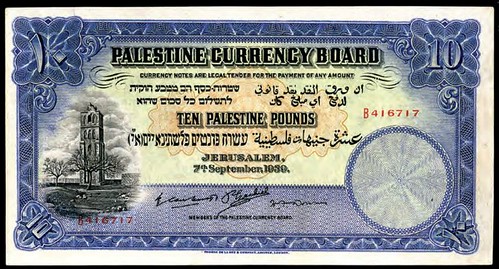
1580 Lemoine Avenue, Suite #7
Fort Lee, NJ 07024
Phone: 201-944-4800
Email: info@archivesinternational.com
WWW.ARCHIVESINTERNATIONAL.COM
THE RHEINISCHES LANDESMUSEUM BONN
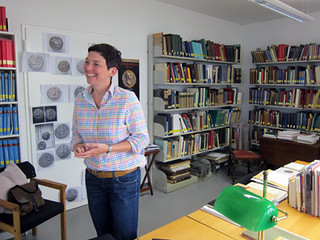 Dr Claudia Klages, head of the numismatic department at the
LVR-Landesmusum Bonn, has quite a lot to offer, more precisely, round about 95,000 numismatic
objects: coins, scales, coin dies, medals and the biggest collection worldwide of currencies and
medals minted and found in the Rhineland.
Dr Claudia Klages, head of the numismatic department at the
LVR-Landesmusum Bonn, has quite a lot to offer, more precisely, round about 95,000 numismatic
objects: coins, scales, coin dies, medals and the biggest collection worldwide of currencies and
medals minted and found in the Rhineland.
This is Dr Claudia Klages, who receives us in her office at the coin cabinet. Behind the door with the pictures of the famous coin type “Tanzendes Männlein” lies the sanctuary, the large, walk-in vault.
The vault contains 95,000 objects, mainly find coins from the Rhineland region … some on trays and some in boxes in order to store the large quantities effectively. The museum is especially well-equipped with Roman coins. Among them, rarities and significant coin hoards, but we will see more of these later when we get to the permanent exhibition.
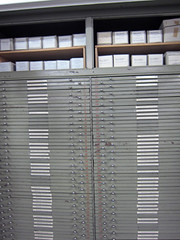

But let’s take a look at the permanent exhibition, which contains an unusually high number of coins and medals. A pleasure for all coin collectors. And if you keep your eyes open, you’ll spot many more objects that are of relevance for economic history.
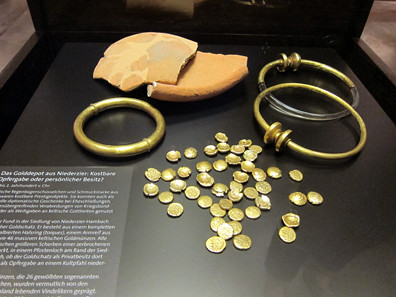

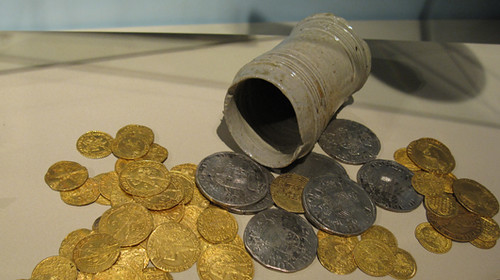
To read the complete article, see:
Numismatics at the Rheinisches
Landesmuseum Bonn (www.coinsweekly.com/en/News/4?&id=3037)
MORE COLONIAL SELECTIONS FROM NEWMAN PART V
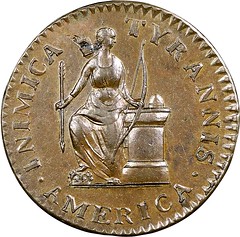
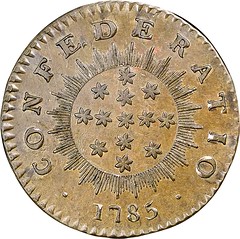
1785 Inimica Tyrannis Cent
1785 Inimica Tyrannis America / Confederatio, Large Circle Cent Original MS63 Brown NGC.
Breen-1123, Whitman-5630, High R.7. 120.6 grains, 99% Copper per NGC metallurgical tests. There are
two obverse dies known for this type, here with the legend INIMICA TYRANNIS AMERICA and in the next
lot, with the legend INIMICA TYRANNIS AMERICANA. The reverse dies are also distinctive, here with
the large circle of stars, and below with a small circle of stars. This extraordinary copper has
full cartwheel luster with choice goldenbrown surfaces showing a few splashes of greenish-steel
toning. Although imperfectly centered, the strike is sufficient to show full border details on both
sides. A tiny planchet defect through the quiver will identify this example.
The obverse motto, "America Opposed to Tyranny," was taken from a longer Latin phrase, "Manus haec inimica tyrannis ense petit placidam sub libertate quietem," attributed to Algernon Sidney circa 1659. Sidney was an English soldier and statesman was opposed to King Charles II; he was executed for treason in 1683. A notice in the November 20, 1755 edition of The Pennsylvania Gazette described Sidney as a "Friend of Peace." The second half of the Latin passage is the official motto of the Commonwealth of Massachusetts. The Large Stars Confederatio pieces are known as decads, the name given to a copper coin valued at approximately one hundredth of a Spanish dollar. A sketch of the design appeared in the papers of the Continental Congress in 1785, and is considered by some as an important pattern issue.
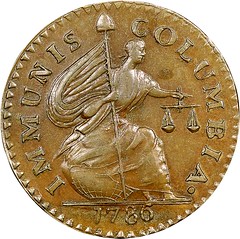
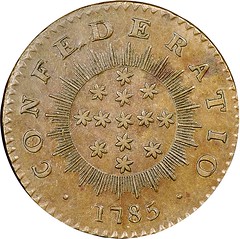
1786/85 Immunis Columbia, Confederatio Mule
1786/85 Immunis Columbia, Confederatio, Large Stars, Crosby VII, 16, Breen-1128, Whitman-5665, MS64
Brown NGC. 159.8 grains. This extremely rare Confederatio piece combines the 1786 Immunis Columbia
obverse with the 1785 Large Stars Confederatio reverse. Walter Breen believed this mule was unique,
and used this piece as the plate coin in his Complete Encyclopedia of U.S. and Colonial Coins. This
is the first example of the variety that we have handled in the 40-year history of our firm. The
Newman specimen is clearly the finest example, and carries the longest provenance. The other known
piece is a corroded VG example that was offered in the 2002 ANA sale with no previous pedigree.
Facts about these pieces are extremely limited and confusing. A series of coins including various combinations of the Immunis Columbia obverse, the Confederatio reverse, and related dies, includes a mule of the 1786 Immunis Columbia obverse and the New Jersey shield reverse, also offered in the present sale. The various pieces are recorded in the Whitman Colonial Encyclopedia under catalog numbers 5630-5700, listing 14 different varieties. These pieces are also punch-linked to the Nova Constellatio coppers of 1783 and 1785. Eric P. Newman believes that these coins, including the Nova Constellatio coppers and the Immunis Columbia pieces, were produced in England, probably at Wyon's Birmingham Mint. Earlier numismatic scholars, including Sylvester S. Crosby held the same belief in the 19th century. More recently, other researchers, including Michael Hodder, have developed an alternative viewpoint that the coins were produced in America.
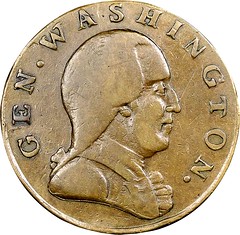
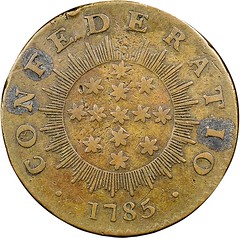
1785 Washington Confederatio Copper
1785 General Washington, Confederatio, Large Circle Copper, Crosby VII, 14, Breen-1125,
Whitman-5665, VF30 NGC. CAC. 128.0 grains, 99% copper per NGC metallurgical tests. This was the
second example discovered according to Sylvester S. Crosby, who reported its earlier history in the
April 1889 issue of the American Journal of Numismatics: Washington Confederatio.
The General Washington obverse die is seen here with the Confederatio Large Circle reverse; it is also known with the New Jersey Shield reverse die C, and the 1786 Heraldic Eagle die, obverse 5 in the New Jersey series. The New Jersey mule lends credence to these pieces being American colonial issues, rather than products of England. However, facts about these coins are just as rare as the coins themselves.
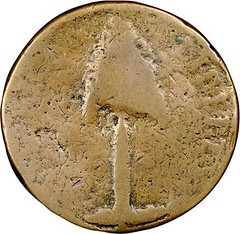

1776 New Hampshire Copper
1776 New Hampshire Pine Tree Copper VG8 NGC. CAC. Breen-708, Whitman-8395, High R.7. 142.0 grains,
99% copper, per NGC test results. The obverse of this simply designed copper features a tall Pine
Tree with the legend AMERICAN LIBERTY, while the reverse depicts a harp with the date 1776. Walter
Breen's Complete Encyclopedia lists six different varieties under the heading New Hampshire
Coppers, but that illustrated and offered here is the only variety that is considered a genuine New
Hampshire copper. Sylvester S. Crosby reproduced the legislation in Early Coins of America and
noted that a copy of the original record of March 13, 1776 included sketched designs that are
nearly identical to the few surviving examples, such as this piece from the Eric P. Newman
Collection.
Facts about these coppers are limited and surviving examples are extremely rare, although reproductions are commonplace. In his book, In Yankee Doodle’s Pocket, Will Nipper writes: "New Hampshire patterns are so rare that the probability of encountering a genuine specimen is almost zero. Yet, copies number in the millions."
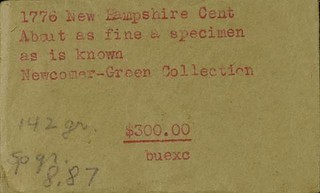 Mark Borchardt of Heritage provided this image
of the storage envelope from the Newman collection. Thanks! -Editor
Mark Borchardt of Heritage provided this image
of the storage envelope from the Newman collection. Thanks! -EditorFor more information, see:
2014 November 14 - 16 Selections from
the Eric P. Newman Collection Part V US Coins Signature Auction - New York #1215
(coins.ha.com/c/auction-home.zx?saleNo=1215)
To read the earlier article, see:
NEWMAN CHALMERS THREEPENCE, SIXPENCE AND
RINGS (www.coinbooks.org/esylum_v17n39a24.html)
THE BOOK BAZARRE
MORE ON THE JOSEPH C. MITCHELSON COLLECTION
Roger Burdette writes:
There are several boxes of archival documents among the Connecticut State Library holdings. I used them for research while writing the Renaissance of American Coinage series. The coins are among the few entirely original pieces remaining in US collections, and many pieces have documented origins direct from the Philadelphia Mint and Annual Assay Commission coins.
David Thomason Alexander writes:
I enjoyed brother Ron Guth's comments about Joseph C. Mitchelson, lovingly known as "Uncle Joe" (1856-1911) to his fellow members of the New York Numismatic Club. This venerable numismatic patriarch did indeed bequeath his magnificent collection to the Connecticut State Library, and a cautionary tale lies therein. Some numismatic luminaries of the past have expressed doubts as to the suitability of museums as repositories of numismatic materials. The late John J. Ford Jr. detested museums and museum people generally, often announcing that museum professionals were worthless incompetents "looking to come in out of the rain." As a former museum director I always resented this arrogant view.
However, the Mitchelson collection offers a fascinating insight into this question. Several years ago, vast swatches of the collection went to auction at Stack's-Coin Galleries, where I had the pleasure of cataloging quite a few fascinating pieces that had been off the market for generations. I believe some items remain in state hands, possibly including the Higley Threepence.
Then there is the Jewish Museum of New York, once famous for its rich numismatic holdings, notably in ancient Jewish coins, now inaccessible in deep, dead storage apparently for good, "and what's it to you!" A few years ago, the Jewish Museum received the Kagan-Maremba Collection of modern Palestine and Israel coins, medals, tokens and paper money. Housed in a "Stonehenge" of custom-built Capital Plastics panels, the collection included obverse-reverse examples of all Israel coins and medals, plus a galaxy of rarities including patterns, trial strikes, unique metal examples, printer's proofs and more. This "ultimate" collection first vanished in the museum's black hole storage, only to emerge as a single auction lot offered by Sotheby's, where it was blown away for a song...
Perhaps most museums are not ideal repositories for numismatic material. Coins and medals are generally small, difficult to see, hard to exhibit to a general audience, incomprehensible to museum staffers and administrators, costly to protect and insure. From a collectors' point of view, returning collections to the marketplace returns them to collectors. Take your pick.
To read the complete article, see:
THE JOSEPH C. MITCHELSON COLLECTION
(www.coinbooks.org/esylum_v17n40a12.html)
TRANSNISTRIA'S POLYMER COINS
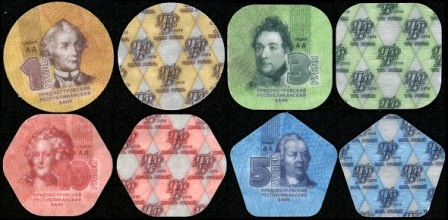
What is the exact definition of a circulation coin?
"A circulation coin is a stamped piece of metal, issued by a competent authority of a recognised sovereign nation, issued at face value and accepted by people at large at face value by reposing trust in the authority"
These are neither metal nor from a recognised sovereign nation. Would you call them coins? I would call them tokens or non-flexible notes, at the best.

AFRICAN-AMERICAN ISSUERS OF CIVIL WAR STORE CARDS
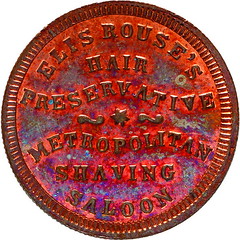 A truly fascinating area of
numismatics.is a study of early African-American token issuers. At a time when African-Americans
did not have equal rights, were generally mistreated in the North and enslaved in the South, there
were a few pioneering black men who issued store cards in the 1860s.
A truly fascinating area of
numismatics.is a study of early African-American token issuers. At a time when African-Americans
did not have equal rights, were generally mistreated in the North and enslaved in the South, there
were a few pioneering black men who issued store cards in the 1860s.
The very first tokens issued in the United States by African-Americans were Civil War tokens. It is arguable as to who the first issuer was, but as I will demonstrate in this article, it was most likely either Charles E. Clark of Cincinnati or McKay & Lapsley of Nashville in 1863.
From the antebellum period until the late 19th century, barbering was primarily a black profession. Also called, "color line barbers", these barbers served only white men and did not allow fellow blacks to patronize their shops for fear of losing their white customers. Barbering was dominated by black men due to an aversion by whites to a trade involving personal service and an attitude by whites that a profession of servitude was appropriate for black men. In fact, every Civil War store card issued by a barber was issued by an African-American.
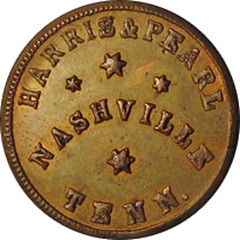 Barbering was a profession that allowed
black men to reach economic levels unachievable in the other limited professions they were allowed
to work in. As will be seen in this article, many black barbers became leading citizens in at least
the African-American portions of their communities. It is an interesting paradox when considering
these barbers had to enforce racial segregation of their own businesses in order to achieve their
success.
Barbering was a profession that allowed
black men to reach economic levels unachievable in the other limited professions they were allowed
to work in. As will be seen in this article, many black barbers became leading citizens in at least
the African-American portions of their communities. It is an interesting paradox when considering
these barbers had to enforce racial segregation of their own businesses in order to achieve their
success.
Many black barbers were actually mulattos, men who had a white father, but were treated as blacks. These men may have had an advantage in that their white fathers freed them and gave them financial assistance in starting their business. The racial classification was not consistent in its usage, so often a person is listed as 'mulatto' in one record and as 'black' or even 'colored' in another record.
It can be safely said that very few 19th century store cards were issued by African-Americans. The following eight merchants, four from Cincinnati and four from Nashville, represent the earliest store cards issued in the United States by African-Americans.
Cincinnati issuers:
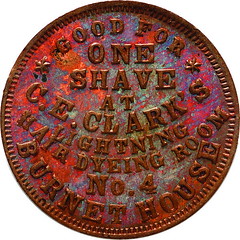 Cincinnati, on the northern banks of the
Ohio River and directly across the Ohio River from Covington and Newport, Kentucky was a city with
many southern sympathizers. In fact, many citizens of northern Kentucky worked in Cincinnati and
either travelled across the bridge or took a ferry in to work. Slavery never existed in Ohio, but
it existed in Kentucky until ratification of the 13th Amendment to the U.S. Constitution on
December, 18, 1865.
Cincinnati, on the northern banks of the
Ohio River and directly across the Ohio River from Covington and Newport, Kentucky was a city with
many southern sympathizers. In fact, many citizens of northern Kentucky worked in Cincinnati and
either travelled across the bridge or took a ferry in to work. Slavery never existed in Ohio, but
it existed in Kentucky until ratification of the 13th Amendment to the U.S. Constitution on
December, 18, 1865.
There was a general hostility toward blacks in Cincinnati and mobs of white men were known to terrorize the black community in the 1860s. After Confederate raids and Union losses in Kentucky in 1862, Cincinnati prepared fortifications to defend against a Confederate attack. Among those helping in the defense of the city was the Black Brigade of Cincinnati of which two Civil War token issuing barbers were members.
Nashville issuers:
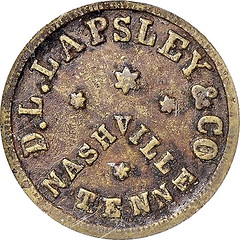 An important shipping port on the
Cumberland River, Nashville was the first confederate capitol to fall when it fell to Union troops
in February, 1862. Many escaped slaves, freed blacks, and other citizens migrated to Nashville due
to its relative safety under the occupation of federal troops and made Nashville a thriving city
during the Civil War. Black citizens helped in the fortification of the city in late 1862 and again
in 1864 prior to the Battle of Nashville which was easily won by Union troops.
An important shipping port on the
Cumberland River, Nashville was the first confederate capitol to fall when it fell to Union troops
in February, 1862. Many escaped slaves, freed blacks, and other citizens migrated to Nashville due
to its relative safety under the occupation of federal troops and made Nashville a thriving city
during the Civil War. Black citizens helped in the fortification of the city in late 1862 and again
in 1864 prior to the Battle of Nashville which was easily won by Union troops.
Despite the occupation of federal troops, slavery was not eliminated by their occupation nor the Emancipation Proclamation that affected only areas under rebel control. Slavery did not officially end in Nashville until early 1865, although its practice was minimal by this time.
For more information on CWTS, see:
www.cwtsociety.com
GADOURY DECEMBER 2014 AUCTION PREVIEW
6 December 2014
Monaco, Éditions V. Gadoury
Vente aux Enchères de Monnaies de Prestige
Rome is at the center of upcoming Gadoury auction sale
Two marvelous collections of coins from Rome – minted by the Roman emperors and the popes – are at the center of the upcoming auction sale of Éditions V. Gadoury. In addition, there are rarities available both from all around the world and from all eras.
On 6 December 2014, one day prior to the Grande Bourse on 7 December, the auction sale of Éditions V. Gadoury will be conducted at the hotel Le Méridien. Although scheduled for a date right in the winter, not only the bright sun will be attracting visitors to Monaco, into the south of Europe.
The sale is kicked off by 22 coins from the Greek world and hence, via the Roman Republic, leads over to the first highlight, a collection of coins from Roman Imperial Times that were assembled with great expertise and taste. Notably the fine bronze coins catch the eye. Just take the – strictly speaking, not quite so rare – dupondius that had been struck in Nimes in modern-day France. The item on offer, featuring the portraits of Augustus and Agrippa, is one of the most beautiful of this type in existence (71, EF, estimate: 2,500 euros). Equally fine at least is the portrait of Iulia Titi on a dupondius that used to belong to the collection of Giuseppe Mazzini (118, about EF, estimate: 6,000 euros). Many rarely encountered coin types are available, of the finest quality and reasonably estimated, like the completely untouched as of Antoninus Pius that depicts the Lavinian sow with her piglets on the reverse (168, EF, estimate: 1,000 euros). The connoisseurs will be amazed by the great number of semises and quadrantes on offer. And there is a large selection of gold coins with moderate estimates available for sale, some in superb quality, like an aureus of Hadrian with the reverse AEGYPTOS (142, about EF, estimate: 6,000 euros) and an aureus of Lucius Verus showing the installation of the Armenian king on the reverse (188, EF, estimate: 6,000 euros). Do we really have to add that any number of attractive denarii is offered for sale as well? The German market is highly likely to fall on the extremely fine – and very much sought-after – denarius of Hadrian whose reverse depicts a perfect Germania with spear and shield (146, EF, estimate: 500 euros).
Coins of the Celts, from the Migration Period and of the Byzantine rulers complete the offer of ancient coins.
The second part of the auction sale comprising world coins and medals begins with – and this is anything but a surprise – a rich selection of coins from Monaco. As pars pro toto we only mention the first piece here, an extremely rare and very early coin of Honoré II dating from 1640 (311, ab. VF, estimate: 5,000 euros). Shortly after Honoré’s accession to the throne, Spain gained control over Monaco. The court at Madrid officially granted him the title of prince not before 1633. This title came with the right to mint money. The item offered here is one of the numismatic testimonies to the Spanish influence on Monaco before Honoré managed to expel the Spanish garrison in 1641.
The focus of world coins coming next is on the Spanish Empire, on France and – comprising about 400 pieces – on Italy.
This is what we would like to start with. The chronological range covers the early Middle Ages until Modern Times. The time of the testone with their interesting Renaissance portraits are particularly well represented. A case in point is an unpublished testone of Savoy of Emanuele Filiberto (1553-1580) whose obverse exhibits a much smaller portrait than his other testone (619, VF, estimate: 6,000 euros). A second rarity likewise is of a Savoy prince – it is an undated ducat of Charles I, minted at Chambery (605, VF, estimate: 10,000 euros).
The most expensive coin of the Italian section is a 5 francs piece from 1814 with the portrait of Napoleon struck for the Département de Gênes around Genova. This administrative unit was established in 1805 after the French emperor had annexed the Ligurian Republic he controlled. In the very year this coin was struck, i.e. 1814, the département was disbanded and awarded to the Kingdom of Sardinia (520, PCGS XF40, estimate: 20,000 euros).
Most probably many collectors will be attracted by the last part of the Italian section comprising more than 200 lots with many coins of the popes, from Stephen V (885-891) to John XXIII (1958-1963). The many different items have one particular element in common: they come with collector-friendly estimates. We single out just one piece at this point, an undated double florin of the notorious Borgia Pope Alexander VI (1492-1503), father of Cesare and Lucrezia (708, VF, estimate: 2,000 euros).
France, too, is well represented with its more than 80 coins. The highlights are an extremely rare demi-écu of Louis XIV, minted in Lille, Gadoury 196 (434, VF / EF, estimate: 8,000 euros) as well as an unusually well preserved 24 livres piece of Louis XVI from 1792, Gadoury 61 (448, EF, estimate: 8,000 euros). Apart from these, a 20 francs piece from 1939 with the obverse coining die of P. Turin (472, EF, estimate: 6,000 euros) is on offer, as is the pattern of this piece for the year 1912, of which only 29 specimens had been made (471, PCGS SP63, estimate: 700 euros).
Anyone fond of Spanish rarities ought to browse through the catalog carefully. After all, we can only direct your attention to a few pieces here, like a 8 escudo of Charles II struck in Segovia in 1687 (408, VF, estimate: 8,000 euros), and another 8 escudo, this time of Philip V, minted in Madrid in 1729 (410, VF, estimate: 9,000 euros). Highlight of the section Spain is an extremely rare and magnificently preserved 5 peseta piece of the Provisional Government from 1869 (414, PCGS SP64, estimate: 20,000 euros). This ‘extemporary’ government was constituted after ‘La Gloriosa’, the glorious revolution in Spain during which Queen Isabella II had been deposited, in order to find a new king.
Naturally, other sections, too, include many an interesting and surprising item. Let us restrict ourselves to a small series of Egyptian coins and the golden 10 roubel piece of Elizabeth I of Russia, minted in St. Petersburg in 1756 (919, ab. EF, estimate: 18,000 euros).
You may order the catalog at Éditions Victor Gadoury, 57, rue Grimaldi, 98000 Monaco; phone: +377 93 25 12 96; telefax: +377 93 50 13 39; email: contact@gadoury.com. Or look at it on the internet at http://auction.gadoury.com/, www.sixbid.com and www.numisbids.com. Live-bidding from your own computer at home of course is also possible!

No. 1: LILYBAION (Sicily). Siculo-Punic tetradrachm, 320-300 B. C. Jenkins 59, 246. Ex Peus 407, 277. Extremely fine. Estimate: 2,500,- euros
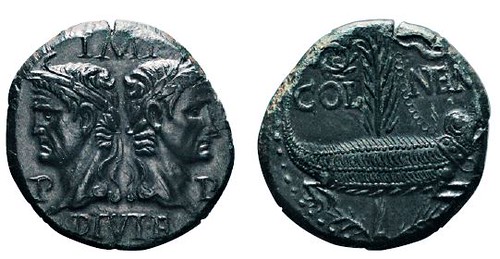
No. 71: AUGUSTUS, 27 B. C. – A. D. 14. Dupondius, Nemausus (Nimes), 10-14. RIC 158. RPC 524. Ex Lanz 145, 50. Extremely fine. Estimate: 2,500,- euros
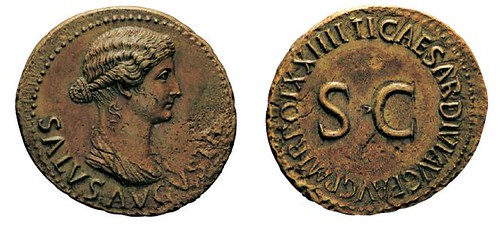
No. 77: TIBERIUS, 14-37. Dupondius, 21-22. RIC 47. Ex NAC 45, 73 “The Barry Feirstein Collection”. Extremely fine. Estimate: 4,000,- euros
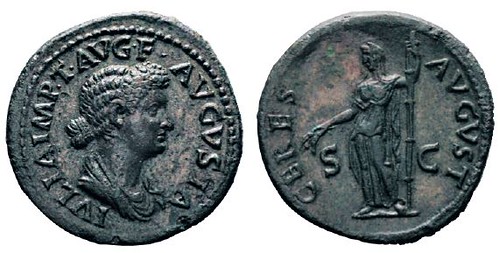
No. 118: TITUS, 79-81. For Iulia Titi. Dupondius, 80-81. RIC 391. From Mazzini Collection. About extremely fine with excellent portrait. Estimate: 6,000,- euros
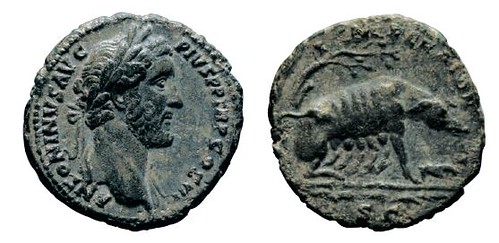
No. 168: ANTONINUS PIUS, 138-161. As, 143-144. Varbanov 2132. Ex Helios 7, 438. Rare. Extremely fine. Estimate: 1,000,- euros

No. 188: LUCIUS VERUS, 161-169. Aureus, 161. RIC 511. Ex Titano 1979, 186. Extremely fine. Estimate: 6,000,- euros
No. 311: MONACO. Honoré II, 1604-1662. 12 gros or fiorino, 1640. Gadoury 6. Extremely rare. About very fine. Estimate: 5,000,- euros
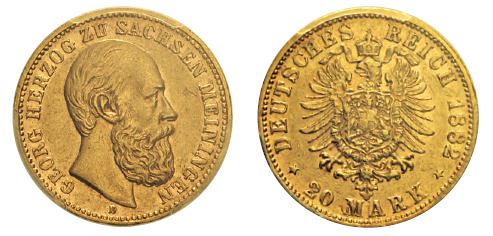
No. 363: GERMANY. Saxe-Meiningen. George II, 1877-1892. 20 mark 1882D. Very rare. PCGS AU50. Estimate: 5,000,- euros
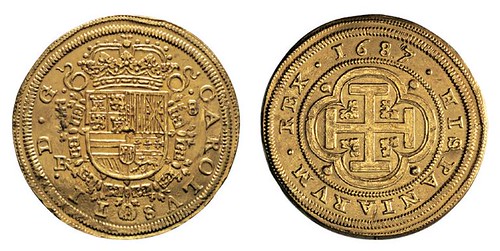
No. 408: SPAIN. Charles II, 1665-1700. 8 escudos, Segovia, BR, 1687/3. Cal. 37. Very rare. Very fine. Estimate: 8,000,- euros
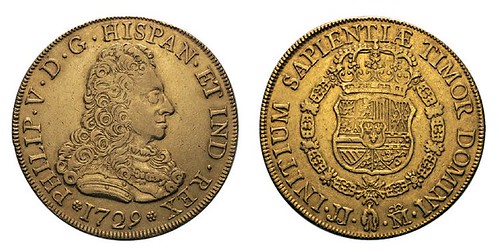
No. 410: SPAIN. Philip V, 1700-1746. 8 escudos, Madrid, JJ, 1729. Cal. 83. Very rare. Very fine. Estimate: 9,000,- euros
No. 414: SPAIN. Provisional Government, 1868-1871. 5 pesetas, Madrid, SN M. Cal. 2. Extremely rare. PCGS SP64. Estimate: 20,000,- euros

No. 434: FRANCE. Louis XIV, 1643-1715. Demi-écu de Flandre aux insignes IIe type, Lille, 1705W. Gadoury 195. Very rare. Very fine / extremely fine. Estimate: 8,000,- euros
No. 448: FRANCE. Louis XVI, 1774-1793. 24 livres, Paris, 1792A. Gadoury 61. Extremely fine. Estimate: 8,000,- euros
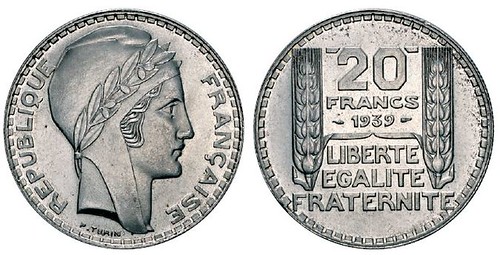
No. 472: FRANCE. Third Republic, 1870-1940. 20 francs, Paris, 1939. Gadoury 852. Very rare. Extremely fine. Estimate: 6,000,- euros
No. 520: ITALY. Département de Gênes, 1805-1814. 5 francs, Genoa, 1814CL. Gadoury 584. Very rare. PCGS XF40. Estimate: 20,000,- euros
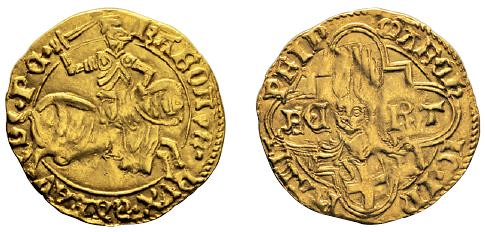
No. 605: ITALY. Savoy. Charles I, 1482-1490. Ducat, Chambery, undated. Friedberg 1026. Very fine. Estimate: 10,000,- euros
No. 619: ITALY. Savoy. Emanuele Filiberto, 1553-1580. Testone, Asti(?), 1560. Unedited. Very fine. Estimate: 6,000,- euros
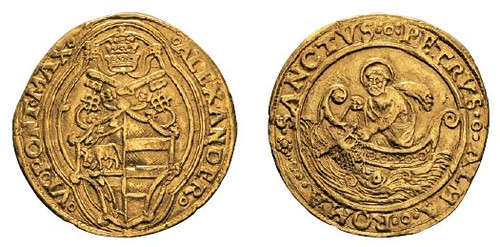
No. 708: ITALY. Vatican. Alexander VI, 1492-1503. Double florin, Rome, undated. CNI 5. Very rare. Very fine. Estimate: 2,000,- euros
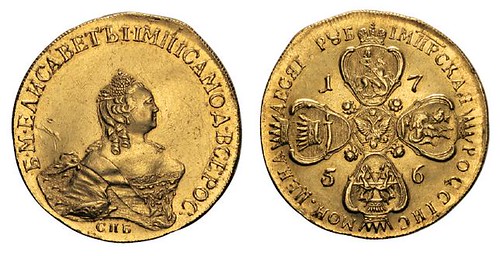
No. 919: RUSSIA. Elizabeth I, 1741-1761. 10 roubel, St. Petersburg, 1756. Bitkin 75. Very rare. About extremely fine. Estimate: 18,000,- euros
For more information, see:
http://www.gadoury.com/en/auction
THE BOOK BAZARRE
NUMISMATICA GENEVENSIS NOVEMBER 2014 SALE
24-25 November, 2014
Numismatica Genevensis SA, Geneva
Auction Sale 8
Coins of Historical Importance in Superb Quality: As Usual at Numismatica Genevensis SA
On 24 and 25 November, 2014, an auction in a class of its own will be conducted in Geneva, by Numismatica Genevensis SA featuring coins from antiquity and the Islamic world as well as world coins and medals including a number of rarities. Many of these are highly likely to break price records.
The elegant Hotel Beau-Rivage located at Lake Geneva will be the setting for one of the most important auction sales of 2014. This is the place where Numismatica Genevensis SA will be conducting its auction sale #8 that comprises a one-of-a-kind offer. Numerous rarities from ancient times, the Islamic world, from Bavaria, Greece, Italy and Switzerland, some of which are estimated at six-digit sums, may very well set new price records.
Starting with the Greek coins, they really make the connoisseur marvel. Many items come from the collection of Joseph J. Grano, who the readers of Businessweek probably know well. Like for example the emblematic stater of the Parisii whose depiction anticipate the art of modern times (Lot 6, estimate: 30,000 CHF). We may skip any reference to its state of preservation. Virtually all pieces on offer are extremely fine at least, and often an item is one of the best or even THE best preserved specimen known. A case in point is the amazing stater of the city of Panticapaeum that once was part of the collection of Russian Grand Duke Alexander Mikhailovich (Lot 31, estimate: 150,000 CHF). In direct comparison, the better known variant of this type with the expressive head of Pan, made at the turn from late Classical to Hellenistic times, almost wanes (Lot 32, estimate: 50,000 CHF).
One would really like to wax lyrical, but we have to restrict ourselves. This is why we would like to mention only two other pieces here: an extremely rare gold stater of Eucratides I (Lot 59, estimate: 50,000 CHF) and an exceptional gold stater of the satrap Ptolemy I, minted in Alexandria in 312-311, that depicts the head of Alexander wearing the elephant skin on its obverse (Lot 61, estimate: 200,000 CHF).
This is only the beginning! What ‘Roman Imperial Times’ have to offer easily tops the just mentioned selection! The fantastic series of perfect aurei must be addressed at this point. Just think of the rare aureus of Postumus showing Neptune on the reverse (Lot 128, estimate: 75,000 CHF). Immediately thereafter come the extraordinarily well preserved bronze coins the highlight of which is the probably finest coin bearing the portrait of Antinoos, favorite of emperor Hadrian, known to exist. It had been struck by the native town of the deceased youth, by Claudiopolis-Bithynion, where Antinoos was worshipped as a god after his death (Lot 94, estimate: 300,000 CHF).
He who hears ‘Probus’ and thinks about inexpensive antoniniani first and foremost will be taught better in this auction sale: there is a gorgeous aureus of this emperor on offer, labelled by the writers of the catalog as one of the finest coins minted in the 3rd cent. A. D. It combines the imperial bust with the one of the sun god (Lot 130, estimate: 200,000 CHF). Next in line is a bronze medallion of the same ruler with full silvering whose reverse is graced by the three Monetae. Here, too, the sun god and the emperor are depicted on the obverse together (Lot 131, estimate: 250,000 CHF).
If that were not enough, 79 items from a ‘Collection of Late Roman with Prestigious Pedigrees’ follow. It goes without saying that this does not refer to those little follis. The spectacular highlight of this collection – that is by no means short of highlights – is the tremissis of Olybrius. This ephemeral emperor ruled in 472, but only for a couple of months. His coins range amongst the great rarities of Roman numismatics (Lot 209, estimate: 200,000 CHF). Do you consider coins of Romulus Augustus the rarer specimens? Well, there is a solidus of him available for sale as well (Lot 211, estimate: 150,000 CHF).
Anyone thinking that he has seen every highlight by now is in fact wrong. The second part of the sale comprises coins of the Islamic world. This is going to be really exciting. What price might be obtained by, let’s say, the drachm from 694 (75 AH) that depicts the praying caliph in great detail (Lot 221, estimate: 20,000 CHF)? And how about the first Islamic gold coin made after the Byzantine model (Lot 226, estimate: 75,000 CHF)?
Unpublished so far was the first Islamic coin of al-Hind, on the Indian sub-continent (Lot 238, estimate: 150,000 CHF). Additionally, two of the four patterns included in the unusual set that had been made in Paris for the Moroccan ruler in 1880/1 (1298 AH) have not been documented until now (Lot 264, estimate: 125,000 CHF).
968 (357 AH) is a year which numismatics knew no gold coin minted in Oman of until now.
Numismatica Genevensis is able to offer an example that was coined on an unusually broad flan thanks to which the inscription is readable in its entirety, thus revealing its historical secrets (Lot 280, estimate: 125,000 CHF). At least as rare is a heavy gold coin of the Safavids in the weight of 56.98g Sulayman I had given as a New Year’s present to a court official in Isfahan in 1685 (1096 AH) (Lot 296, estimate: 100,000 CHF). These donatives are rare even when made of silver. What will this outstanding piece obtain? Let us conclude this part of the auction preview with two rare coins from the Indian Mogul Empire. His ruler Jahangir had not only a series of gold coins minted that depict the zodiac signs on one side. Some of these he even graced with his own portrait in addition. This makes these specimens the earliest ruler portraits on Mogul coins and a very early testimony to portrait art on Islamic coins (Lot 307, estimate: 100,000 CHF).
Quite another background does an extremely rare piece of the British East India Company have: in 1770 (1184 AH), a 15 rupee piece was issued that stated the name of the ruler – who, however, had not been asked for his permission in advance. Alamgir felt insulted, and the East India Company, that faced serious economic trouble in those days, chose the easier way and melted the entire emission down before it was put into circulation. Only very few pieces survived (Lot 310, estimate: 125,000 CHF).
This takes us to the third part of this auction sale: world coins. ‘Last, but not least’ does not really catch what is coming next. Most auction houses would count themselves lucky if they had just this part of the auction sale at their disposal, to conduct one of the biggest sales in their entire history. Let us single out merely two rarities from the German Empire. The connoisseur discovers an extremely rare 20 ducat piece from Bavaria, issued in 1806. It is nothing less than the biggest German gold coin of the 19th century (Lot 316, estimate: 200,000 CHF). Not to omit the probably unique 10 gold gulden of Frederick William III of Saxe-Altenburg dating from 1672 (Lot 323, estimate: 100,000 CHF)!
This is only topped by the very rare example of the gold pattern of the first thaler in the weight of 7 ducats from the collection of Count Arthur von Enzenberg. This piece was probably minted in 1563, on the occasion of Emperor Ferdinand I visiting the mint of Hall together with his sons Maximilian and Charles (Lot 331, estimate: 250,000 CHF). One of his successors, Leopold I, is also present, with a 10 ducat piece, minted in Breslau in 1663, one of the rarest Habsburg multiples known to numismatics (Lot 333, estimate: 150,000 CHF).
Now, it is faraway Asia’s turn. It will be really fascinating to see what price a small series of gold dollars from 1916 and 1923 will obtain that were minted in the important harbor town of Tian-Tsin (Lot 354-358; estimates per lot ranging between 20,000 and 30,000 CHF).
Something for the special collector only is the extraordinary collection of patterns for coins of French Indochina. The item that stands out the most is an undated essay for the tael from Hanoi from 1943 of which only two specimens are known to exist (Lot 425, Estimate: 10,000 CHF).
Reference should also be made of the coins of modern-day Greece. Numismatica Genevensis is able to offer not just an example of the emission of 100 drachmae from 1876, which is extremely rare given the fact that only 76 pieces had been minted in Paris (Lot 445, estimate: 75,000 CHF), but an even rarer pattern – with as few as 5 known examples – of the emission from 1875 (Lot 444, estimate: 250,000 CHF).
The rarities even grow in number when we turn to Italy. 5 out of 74 pieces have six-digit estimates, and another 8 have been estimated at sums between 50,000 and 100,000 CHF. 29 lots carry pre-sale price tags of 10,000 CHF and more. One brief look at the three ‘frontrunners’: a 10 ecu piece in gold, minted by Victor Amadeus in Turin in 1634 (Lot 463, estimate: 250,000 CHF), 50 lire of the Kingdom of Italy from 1864, that had a mintage of no more than 103 specimens (Lot 482, estimate: 250,000 CHF) and the rarest coin of the Napoleonic era, the famous 5 lire of Parma 1821, depicting the second wife of Napoleon, Marie-Louise of Austria, on the obverse (Lot 522, estimate: 150,000 CHF).
Let us conclude this auction preview with one final bombshell: a 20 ducat piece from Basel, made from the thaler dies of 1741. It is the only specimen available on the market. The second known example – of poorer quality – is now housed in the Swiss National Museum in Zurich (Lot 581, estimate: 500,000 CHF).
You can find the catalog on the internet at www.ngsa.ch. You may also order it at a protective fee of 50 EUR at Numismatica Genevensis SA, Rond-Point de Plainpalais 1, CH-1205 Genève, phone: +41 / 22 / 320 46 40, e-mail info@ngsa.ch.
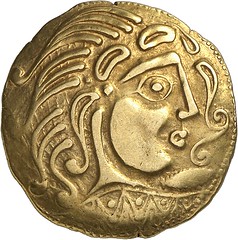

Lot 6: PARISII. Gold stater, 2nd cent. B. C. DT 79. From J. J. Grano Collection and ex NGSA 1 (2000), 1. One of the best examples known. Estimate: 30,000,- CHF
Lot 31: PANTICAPAEUM (Black Sea Region). Gold stater, around 360-350 B. C. Anohin 91. From the collection of Grand Duke Alexander Mikhailovich and the J. W. Garrett Collection. Extremely fine. Estimate: 150,000,- CHF
Lot 59: EUCRATIDES, King of Bactria 170-145. Gold stater, Pushkalavati. Mitch. Type 176var. From the J. J. Grano Collection and ex NGSA 2 (2002), 67. Extremely fine. Estimate: 50,000,- CHF
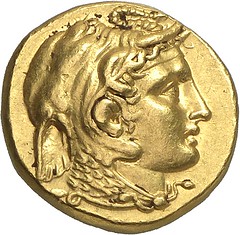

Lot 61: PTOLEMY, Satrap of Egypt 323-305. Gold stater, 312/1, Alexandria. Unpublished. Extremely fine. Estimate: 200,000,- CHF
Lot 94: ANTINOOS. Bronze medallion, Bithynion. Blum 8, pl. II. 15. Ex Giessener Münzhandlung 76 (1996), 310. The finest coin bearing the portrait of Antinoos known to exist. Estimate: 300,000,- CHF
Lot 128: POSTUMUS, 259-268. Aureus, 260-268, Lyon. RIC IV/3, 339, 30B. Rare. Extremely fine. Estimate: 75,000,- CHF
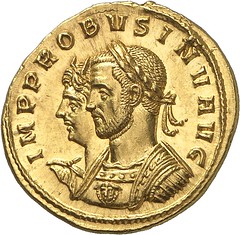
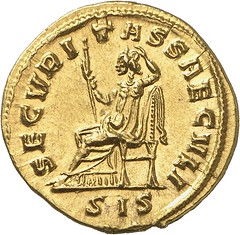
Lot 130: PROBUS, 276-282. Aureus, Siscia. RIC IV/3, 80, 596(corr). Extremely rare. One of the finest coins of the 3rd. cent. A. D. Estimate: 200,000,- CHF
Lot 131: PROBUS, 276-282. Bronze medallion with silvering. Gnecchi II, p. 119, cf. 33 and pl. 121, 3 (same die). From the William James Conte collection, NAC 51 (2009), 402. Probably the finest medallion of the 3rd cent. A. D. Estimate: 250,000,- CHF
Lot 209: OLYBRIUS, 472. Tremissis, Milan. RIC 3004. From the collections Ponton d’Amécourt , Jameson 538 and Mazzini. Extremely rare. Very fine. Estimate: 200,000,- CHF
Lot 211: ROMULUS AUGUSTUS, 475-476. Solidus, Rom. RIC 3404. From the Millenia Collection. The finest coin of the last king of the Western Roman Empire known to exist. Estimate: 150,000,- CHF
Lot 221: ARABO-SASANIDS. Bishr b. Marwan, AH 73-75 (692-694). Drachm AH 75 (694), Basra. A 27.1. Extremely fine. Estimate: 20,000,- CHF

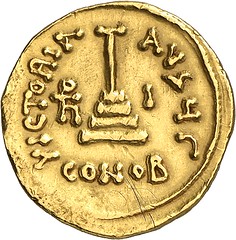
Lot 226: ARABO-BYZANTINIE COINS. Umayyads. Undated Arabo-Byzantine solidus, around AH 60-72 (679-691) and the Byzantine solidus that served as model. Very fine to extremely fine. Estimate: 75,000,- CHF
Lot 238: UMAYYADS. Suleiman, AH 96-99 (715-717). Dirham AH 97 (715/16), al-Hind. Unpublished unique specimen. Very fine. Estimate: 150,000,- CHF
Lot 280: OMAN. Umar b. Muhammad, AH 357-358 (967-968). Dinar AH 357 (968), Oman. Unpublished unique specimen. Very fine. Estimate: 125,000,- CHF
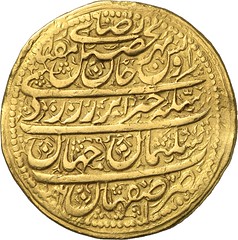
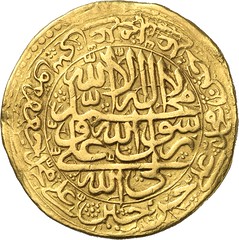
Lot 296: SAFAVIDS. Suleiman I, AH 1079-1105 (1668-1694). 20 ashrafi AH 1096 (1685), Isfahan. A M2657. Very fine. Estimate: 100,000,- CHF
Lot 307: MUGHAL EMPIRE. Nur-Ud-Din Muhammad Jahangir, AH 1014-1037 (1605-1628). Portrait mohur AH 1020 (1611). Fr. 758. Extremely fine. Estimate: 100,000,- CHF
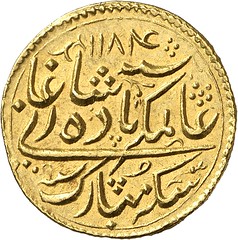

Lot 310: INDIA. Presidency of Bombay. Mohur worth 15 rupees AH 1184 (1770), Bombay. KM 183. Ex NGSA 4 (2006), 698. Extremely rare. Extremely fine. Estimate: 125,000,- CHF
Lot 316: GERMANY. Bavaria. Maximilian Joseph, 1806-1825. 20 ducats 1806. Kahnt 65c. Unique specimen. Ex Hirsch 20 (1959), 182a. Extremely fine. Estimate: 200,000,- CHF
Lot 323: GERMANY. Saxe-Altenburg. Frederick William III, 1669-1673. 10 gold gulden 1672. Fr. 2913. Unique specimen. Extremely fine. Estimate: 100,000,- CHF
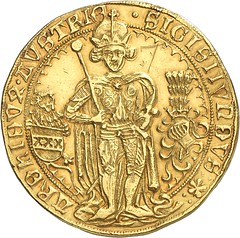
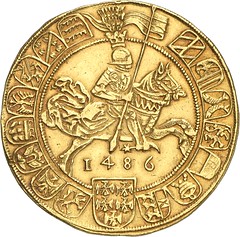
Lot 331: HRE. Sigismund, 1446-1496. 7 ducats 1486 (1563), Hall. Fr. 7. From the Arthur Graf Enzenberg Collection. Extremely fine. Estimate: 250,000,- CHF
Lot 333: HRE. Leopold I., 1657-1705. 10 ducats 1663, Breslau. Fr. 258a. Extremely rare. Extremely fine. Estimate: 150,000,- CHF
Lot 370: MEROVINGIANS. Chlothar II, 584-613. Solidus, Arles. Depeyrot 10var. From the J. J. Grano Collection and ex NGSA 3 (2004), 377. Very rare. Very fine. Estimate: 50,000,- CHF
Lot 444: GREECE. George I, 1863-1913. Pattern of 100 drachmae 1875, Paris. Divo P71. Mintage: only 5 specimens. FDC. Estimate: 250,000,- CHF
Lot 463: ITALY. Vittorio Amadeo I, 1630-1637. 10 ecus d’or 1634, Turin. Fr. 1062. Extremely rare. Extremely fine. Estimate: 250,000,- CHF
Lot 482: ITALY. Vittorio Emanuele II, 1861-1878. 50 lire 1864 T, Turin. Fr. 10. Mintage: only 103 specimens. Extremely fine. Estimate: 250,000,- CHF
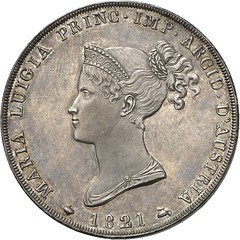
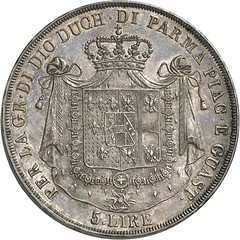
Lot 522: ITALY. Marie-Louise of Austria. 5 lire 1821, Milan. Mont. 116. Ex Sternberg 1984, 739. The rarest coin of the Napoleonic era. Extremely fine. Estimate: 150,000,- CHF
Lot 559: RUSSIA. Alexander I, 1801-1825. Pattern for ruble 1801, St. Petersburg. Bitkin 632. Ex Künker 181 (2011), 1388. Extremely fine. Estimate: 100,000,- CHF
Lot 581: SWITZERLAND. Basel. 20 ducats 1741. Fr. 56. FDC. Estimate: 500,000,- CHF
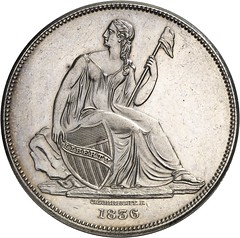
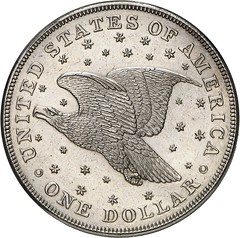
Lot 666: USA. 1 dollar ‘Gobrecht’ 1836. KM 59. From the ANS Collection. Very rare. Extremely fine. Estimate: 20,000,- CHF
For more information, see:
www.ngsa.ch

1924 MILWAUKEE SPEEDSKATING MEDAL RETURNED TO FAMILY
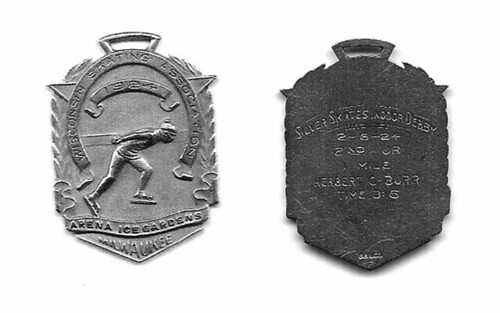
Who is Herbert C. Burr?
That's what the folks from Veldhoven, a village in the Netherlands, wanted to know after finding Burr's 1924 speedskating medal from Milwaukee.
The dirt-caked medal was discovered in someone's garden in the 1980s or thereabouts, alongside the road where American and other allied forces rolled in when they freed the Dutch people from Nazi occupation during World War II.
This is the most intriguing aspect for the village.
"We think that this medal had been lost by one of our liberators, coming from Wisconsin, in September/October 1944!" Jan van den Boom wrote in an email this summer to the Wisconsin Speedskating Association, the successor to the Wisconsin Skating Association, which awarded the medal to Burr.
Clearly, America's military help used to be met with more enthusiasm than we see these days in the Middle East.
So if the medal was found 25 or more years ago, why is this coming up now?
Liberation came 70 years ago this month, and van den Boom serves on a committee that arranged an exhibition to mark the occasion. The group made a public plea for articles, photographs and other items related to the war.
"And so came the skating medal of Herbert C. Burr in my life," van den Boom told me. "Someone stood in front of my door. He had read our call and asked me, 'Is this something for your committee?' "
The person explained that his father-in-law had found it while digging in his garden with a shovel. The medal had a frayed ribbon attached. The father-in-law tossed it in a box, and it wasn't until years later after his death that the medal was noticed and cleaned up.
The front of the medal says, "Wisconsin Skating Association, 1924, Arena Ice Gardens, Milwaukee." And on the back: "Silver Skates Indoor Derby, 2-6-24, 2nd, Jr., 1 mile, Herbert C. Burr, Time 3:16."
Van den Boom found the association's website and sent an email to a contact name he found there, Amy Decker. He explained how the medal was found, and he asked if Burr had been a member of the association, if he was indeed involved in the liberation, if he survived the war, if he has living relatives, and if a photo of him is available.
Census records indicate Burr married a woman named Myra and had two daughters, Barbara in about 1932 and Sandra in about 1937. Old city directories show the family living in the 5900 block of W. Roosevelt Drive in Milwaukee from the 1940s until at least the 1970s. Herbert Burr worked at Gugler Lithographic Co.
I was able to reach Burr's daughter, Barbara Neubauer, who was listed as a representative in her mother's probate court file. She lives in Milwaukee.
"Oh, my gosh, you've got to be kidding," she said when I called to tell her about the medal.
Her father never served in the military and, in fact, never set foot in the Netherlands. But Barbara and her husband lived there in Veldhoven from 1981 to 1983 because of his job.
Barbara knows exactly how her father's medal wound up in the garden. Her home there was burglarized in 1982 while she was away for the weekend. The medal was in a drawer that was ransacked and it was stolen along with her mostly costume jewelry.
The crooks, apparently disappointed they didn't get a better haul, discarded the items along a path near Barbara's house and apparently also in someone's garden.
It's been a long strange trip for this medal, but it will soon be on its way back to Milwaukee to the family of Herbert C. Burr.
To read the complete article, see:
1924 Milwaukee speedskating medal center of overseas mystery
(www.jsonline.com/news/milwaukee/1924-milwaukee-speedskating-medal-center-of-overseas-mystery-b99359918z1-277329701.html)
A VISIT TO BANKNOTE PRINTER DE LA RUE
 GATESHEAD makes more money than any other town in Britain, but you will struggle to find anyone who
will talk about it.
GATESHEAD makes more money than any other town in Britain, but you will struggle to find anyone who
will talk about it.
Sitting a few hundred yards from Retail World on Team Valley is the largest commercial banknote factory in the world.
It’s all bit hush-hush. I can only tell you a fraction of what I saw when I was given a rare glimpse inside De La Rue – the North-East factory with a licence to print money.
This year the Gateshead plant marks its half century.
Nearly 600 people work here, about two thirds of them in the banknote facility that converts blank sheets of paper into dinars, dollars and much more.
The company, which traces its roots back 201 years to Thomas de la Rue’s London straw hat shop, has won scores of awards for its quality and innovation.
The Gateshead factory, which has a sister plant in Debden, Essex, makes about ten million banknotes a day – up to 3.1 billion a year.
Each note possesses a unique serial number and is produced to the most exacting standards. This year alone the firm's North-East will make 75 different denominations for clients across the world.
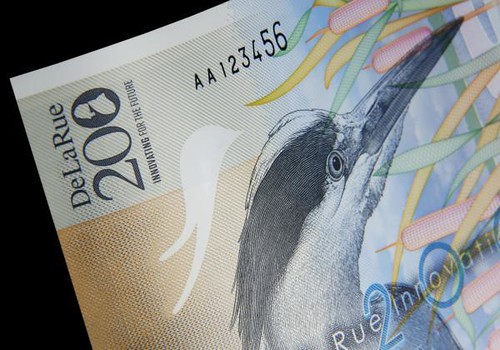
A dummy house note showing the firm's printing and design skills
We often talk about firms in our region being hidden gems. It is part of a business reporter’s job to shout about the great companies that often go unnoticed.
For obvious reasons, De La Rue is about as low profile as a Stock Exchange-listed company can be.
Securing access to this place was no mean feat. Getting a job here is nearly as tough as joining MI5.
Background checks on job applicants are so detailed it means the recruitment process for production line staff can take up to eight months.
Once people secure a job here they are advised to talk as little as possible about their workplace, and are even encouraged to come up with the name of an alternative employer to tell friends or family.
One worker tells me that he had led his children to believe he worked for Pyrex, which was fine until the glassmaker went bust and his kids fretted that dad was headed for the dole queue.
Security here is Fort Knox tight. Again, I can’t disclose much detail, but it’s safe to say that the typical factory visits I’ve been on don’t require multiple body searches.
I’m allowed inside only after I’ve produced my passport, emptied pockets, had my photograph taken and gone through a series of security gates where more ID checks are taken.
The first thing you notice inside the plant is the light. It’s a gloomy early autumn day outside, but the factory floor is as bright as an operating theatre. Being able to spot potential flaws before the production process goes too far can save the company a small fortune. It’s warm too – unusually so for a factory – as the air conditioning is set precisely to match the air temperature of the factory where De La Rue makes its paper. This prevents the sheets from shrinking or warping.
Away from the main production area are small side rooms – one contains washing machines testing the durability of notes left in the pockets of jeans – while another is an oasis of calm where craftsmen tap away to remove tiny blemishes from the surface of the metal printing plates that bear the notes’ original image.
We pass a printer churning out this year’s Christmas stamps, and head to the end of the production line where finished blocks paper, now worth thousands of pounds, are being fed into a guillotine, before being stacked on pallets awaiting dispatch.
Bound into bundles they suddenly look less exotic, more real. The people who will use them will probably never give the details on the notes a second glance. They will barely notice that the grain on one side is more pronounced, or that the ink on a note fresh from a cash dispenser will smudge if rubbed hard enough.
They certainly won’t think about Gateshead. But they should.
To read the complete article, see:
A licence to print money (but keep it quiet)
(www.thenorthernecho.co.uk/business/spotlighton/11506497
.A_licence_to_print_money__but_keep_it_quiet_/)
BALDWIN’S NUMISMATICS MOVE TO 399 STRAND
Renowned numismatic dealer and auctioneer ‘A.H. Baldwin & Sons Ltd’ are delighted to announce that from Monday 27 October 2014 they will join Stanley Gibbons in their newly renovated, bespoke designed premises on the Strand, London.
Ian Goldbart, Managing Director said: “The move to join our colleagues at Stanley Gibbons represents a progressive new phase in the evolution of the Group and an exciting opportunity for our clients. We are thrilled that from October we will be based at the flagship location for a group of companies operating at the pinnacle of the global collectibles market.”
Located opposite the Savoy on the Strand, the newly refurbished space will bring both our retail and auction clients an enriched experience. A new custom designed auction room on the lower ground floor will become the permanent home for our prestigious London sales whilst private consultation areas and a retail showroom on the first floor will now offer a dedicated viewing space for our substantial and diverse stock.
Our team will continue to attend auctions and numismatic fairs all over the world to source the rarest and best quality material available. Baldwin’s Auction Department will still hold a full calendar of sales in Hong Kong and New York alongside our London sales at the new 399 Strand premises, conveniently located very near to Charing Cross and Embankment stations. With a history dating back to 1872, our team of specialists have over 300 years combined experience covering all areas of numismatics including English, Ancient and Foreign coins, military and commemorative medals, tokens, books and banknotes. Over our long history we built up an impressive reserve of excellent numismatic items and provided important coins for numerous collectors.
In 2013, Baldwin’s became part of The Stanley Gibbons Group plc, and can now offer collectors the complete package of coins, stamps, books, fine art and other collectibles. Our sister companies include fine art and antiques specialist ‘Dreweatts & Bloomsbury Auctions’, autographs and collectibles specialist ‘Fraser’s Autographs’ and of course, philatelic specialist ‘Stanley Gibbons’, but we would like to take this opportunity to assure valued clients that all aspects of the Baldwin’s business will remain the same at the new address:
A.H. Baldwin & Sons Ltd, 399 Strand, London WC2N 0LX
For further information on the move and on the forthcoming activities at Baldwin’s or at any of our sister companies, please visit www.baldwin.co.uk or contact us on info@baldwin.co.uk.

POTLATCH COPPERS
Potlatch coppers: wealth and power on the Northwest Coast
John Davy, Collaborative Doctoral Student, British Museum
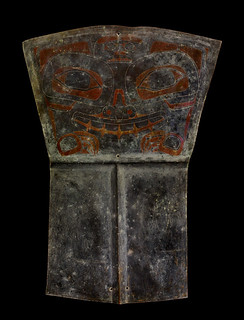
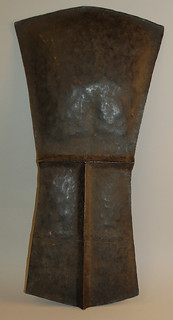
Two potlatch coppers acquired by the British Museum
Last year I began a Collaborative Doctoral Award at the British Museum and UCL studying Native American material culture, having worked for the Americas section of the Department of Africa, Oceania and the Americas at the Museum since 2008. In this post I want to introduce two new acquisitions that help the Museum illustrate the complex wealth-exchange systems of the North Pacific coast of North America.
At times of celebration, the wealthiest and most powerful chieftains among the tribes of the Northwest Coast would hold great ceremonial events, known as potlatches. These occasions could last several days, featuring a series of expansive feasts accompanied by dancing, singing and the telling of ancestral stories in the chieftain’s plank-built longhouse. During the potlatch, open negotiations over hunting territories and trading rights would be conducted, the host demonstrating his power and wealth by ostentatious demonstrations of disregard for danger.
The anthropologist Franz Boas describes an event that took place among the Kawkwaka’wakw:
When a person gives a grease feast, a great fire is lighted at the centre of the house. The flames leap up to the roof and the guests are almost scorched by the heat. Still the etiquette demands that they do not stir, else the host’s fire has conquered them. Even when the roof begins to burn and the fire attacks the rafters, they must appear unconcerned. The host alone has the right to send a man up to the roof to put out the fire.
At the climax of the event the host would address his guests in a ceremony centred on the distribution of lavish presents. Most significant of all gifts would be large sheets of shield-shaped copper decorated in a variety of tribal crests. These objects are known by various names: tináa to the Tlingit, t’agu to the Haida and collectively in English as ‘coppers’. Often individually named with complex life-histories, coppers carried a nominal value measured in blankets or slaves, but their importance lay primarily in the obligation they placed on the recipients as part of a network of wealth and power distribution.
To the people of the Northwest Coast, copper was an exotic item, originally traded from the north and later with Europeans. It held supernatural properties, and to present a guest with a copper or a piece from a broken copper placed on them a powerful obligation. A host who had received coppers from his guests at their potlatches was compelled to present them with a greater value of coppers than he had previously received and thus obliged his guests to present coppers of even greater value at their next potlatch. The wealthiest chieftains would even smash coppers or throw them into the sea to demonstrate their superiority and strength. A leader who could not afford to make these presents or did not possess coppers could not hold a successful potlatch to celebrate important events and would consequently be considered a man of little importance among his peers.
In the late 19th century, colonial authorities saw the potlatch as a dangerous, wasteful and subversive event and sought to stamp it out. It was outlawed in Canada in 1884 and in 1921 Dan Cranmer’s potlatch at 'Mimkwa_mlis (Village Island) was raided by the local police who seized and confiscated hundreds of items of regalia. Potlatching did not cease, but it was forced underground, becoming invisible to the authorities as the regalia which supported it was gradually dispersed to museums and private collections around the world. Since the removal of the anti-potlatch laws in 1951 however, potlatching has once again become a prominent part of life for the people of the North Pacific.
To read the complete article, see:
Potlatch coppers: wealth and power on the Northwest Coast
(blog.britishmuseum.org/2014/10/01/potlatch-coppers-wealth-and-power-on-the-northwest-coast/)
THE POTLATCH DOLLAR PENDANT
 The second acquisition is a pendant produced by
contemporary Tlingit artist Alison Bremner. Titled ‘Five’ from her series ‘Potlatch Dollars’, this
pendant is made from copper in the shape of a traditional copper. Printed onto the surface of the
pendant is a detail from a $5 note originally issued in Seattle. Bremner writes:
The second acquisition is a pendant produced by
contemporary Tlingit artist Alison Bremner. Titled ‘Five’ from her series ‘Potlatch Dollars’, this
pendant is made from copper in the shape of a traditional copper. Printed onto the surface of the
pendant is a detail from a $5 note originally issued in Seattle. Bremner writes:
Potlatch Dollars resulted from my consideration of the concept of money, as any self-employed artist will do. Tináa’s once held a money-like value that today is held by dollar bills. Money is the object that contemporary society chooses to place value on.
As a child of two cultures, I view these works less as an appropriation from one culture to another but as a joining of the two. The Potlatch Dollar is a symbol of the past and present that all Northwest Coast residents now live in.
In juxtaposing 19th-century embodiments of Native and non-Native conceptions of wealth, Bremner is highlighting both the similarities and the misunderstandings that have characterised Native and non-Native relations over the last two centuries and celebrates the re-establishment of traditional Native practices in recent decades.
To read the complete article, see:
Potlatch coppers: wealth and power on the Northwest Coast
(blog.britishmuseum.org/2014/10/01/potlatch-coppers-wealth-and-power-on-the-northwest-coast/)
2015-2016 AMERICAN PLATINUM EAGLE REVERSE DESIGNS
The United States Mint recently provided the Commission of Fine Arts (CFA) and the Citizens Coinage Advisory Committee (CCAC) with a set of 30 design candidates for the reverse of the 2015-2016 American Platinum Eagles. The two groups each offered different recommendations on their preferred set of designs.
When the Commission of Fine Arts reviewed the design candidates on September 18, they noted the appearance of an allegorical figure of Lady Liberty on the obverse and supported depictions of eagles for the upcoming reverse designs.
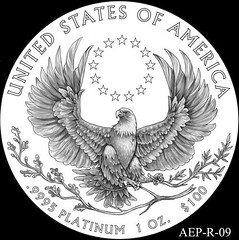
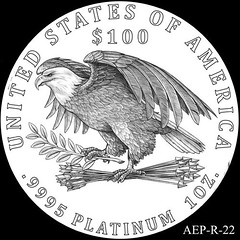
For 2015, they recommended alternative #9 which depicts a bald eagle grasping an olive branch in its talons to symbolize peace. The eagle’s wings are outstretched to represent its boundless spirit of freedom and a circle of 13 stars above the eagle’s head represent the original 13 colonies.
As a potential continuation of the series in the following year, they recommended alternative #22. The design features a depiction of an American bald eagle as a symbol of strength and freedom. The eagle is depicted in the heraldic tradition with its talons grasping an olive branch to symbolize peace and bundle of 13 arrows to symbolize the strength and ability to protect. The CFA suggested refining the awkward position of the eagle’s legs and to consider replacing the bundle of arrows with wheat stalks.
The Citizens Coinage Advisory Committee reviewed the design candidates on September 24 and opted for a different set of designs.
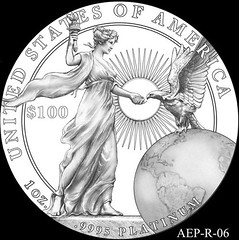
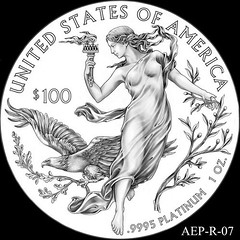
They recommended alternative #6 which carries a depiction of Liberty and an American bald eagle representing Freedom. In the image, Liberty is shown nurturing and sustaining Freedom. The CCAC suggested removing the dish in Liberty’s hand and rather showing the hand as open and extended. They further suggested showing eye contact between Liberty and the eagle, removing the inner line concentric with the “United States of America” text to create a cleaner design, and repositioning the Earth to show the United States.
Their second recommendation was for alternative #7, which depicts Liberty with flowing hair and robe waving in the winds of freedom. Liberty holds a torch of enlightenment in her right and and an olive branch in her left. A bald eagle is shown clutching an olive branch with its wings outstretched to represent its boundless spirit. The CCAC suggested removing the olive branch in the eagle’s talons to create a cleaner design.
To read the complete article, see:
CFA
& CCAC Recommend 2015-2016 American Platinum Eagle Reverse Designs
(news.coinupdate.com/cfa-ccac-recommend-american-platinum-eagle-reverse-designs-4504/)
For the complete roster of design candidates, see:
2015-2016
American Platinum Eagle Reverse Design Candidates
(mintnewsblog.com/2014/10/2015-2016-american-platinum-eagle-reverse-design-candidates/)
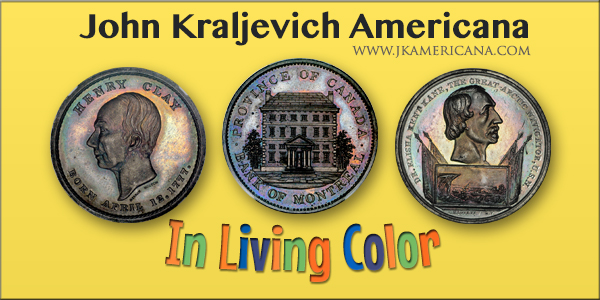
FLIGHT 93 CONGRESSIONAL GOLD MEDAL SAFE FROM FIRE
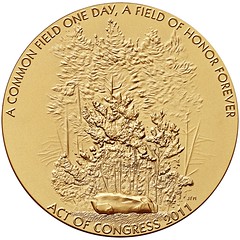
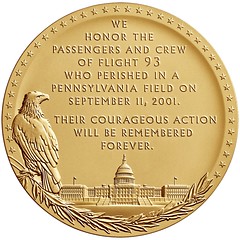
A fire at the Flight 93 National Memorial destroyed three administrative buildings on Friday, leaving officials concerned about some of the memorabilia and archival material stored there.
Wind-whipped flames didn't touch the under-construction memorial and visitors center, which are about 2 miles away on the large property in rural western Pennsylvania, National Park Service spokesman Mike Litterst said. No one was injured in the fire, whose cause is under investigation.
The buildings comprised the park's headquarters, with conference facilities, storage space and the superintendent's office. About 10 percent of the memorial's archival collection was kept on site, and many objects were in fireproof safes, officials said.
Park staff saved an oral history collection and photo collection. The Congressional Gold Medal awarded to the memorial last month was not on site, officials said, but a full inventory will have to wait.
Officials have said they hope construction of the visitors center, which is estimated to cost $17 million to $23 million, will be finished by June. That would give park officials three months to install exhibits in time to open for the 14th anniversary of the crash.
To read the earlier E-Sylum article, see:
CONGRESSIONAL GOLD MEDALS FOR 9/11
HEROES (www.coinbooks.org/esylum_v17n38a10.html)
To read the complete article, see:
Fire
destroys 3 buildings at Flight 93 memorial
(www.msn.com/en-us/news/us/fire-burns-3-buildings-at-flight-93-memorial-site/ar-BB7iIrn)
THE SMALLEST UNITED KINGDOM COIN EVER STRUCK

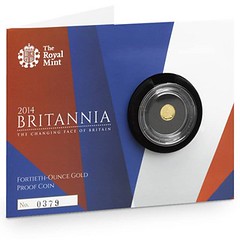
In fine gold, on the smallest United Kingdom coin ever struck
The elegance of Britannia is beautifully suited to this astounding Fortieth-Ounce coin, the smallest coin to be struck since the forming of the United Kingdom more than 300 years ago, a triumph of The Royal Mint’s artistry and craftsmanship. Struck in 999.9 fine gold and perfected by the gleam of The Royal Mint’s Proof finish, this delicate coin is presented in sophisticated packaging, which reveals how Britannia has evolved through the ages, while a certificate confirms that this is a Limited Edition Presentation of just 9,650.
Britannia has personified Britain for almost 2,000 years, reimagined time and time again on the coins of the realm, each new portrait a new display of her strengths and those of the nation she represents. Jody Clark’s latest interpretation is undoubtedly a modern composition, with its elegant lines especially on the three-dimensional globe and dynamic movement in the flowing robes and hair of Britannia, yet he recalls centuries of tradition with some more familiar elements. The lion, no stranger to the coins of Britain, lies loyal and tamed at Britannia’s feet – the pairing a display of patriotic strength.
For more information, or to order, see:
The
Britannia 2014 Fortieth Ounce Gold Proof Coin
(www.royalmint.com/shop/The_Britannia_2014_Fortieth_Ounce_Gold_Proof_Coin)
FEATURED WEB PAGE: VIETNAMESE DONG
This week's Featured Web Page features examples of Vietnamese banknotes.Vietnamese banknotes have gone through many changes since they first appeared as colonial banknotes.
After King Ho Quy Ly failed to enforce the law on using paper money instead of bronze coins, French Indochines piastre was the first banknote to have appeared in Vietnam. The note was circulated in Vietnam, Laos and Cambodia. The French issued and maintained the notes from 1885 to 1954.
After the August Revolution in 1945, the government of the Democratic Republic of Vietnam was born, and issued the first dong to replace the piastre. The numbers were presented in Vietnamese, Arabic, Chinese, Laotian and Khmer. The notes were circulated from 1946 to 1978.
The Republic of Vietnam in the south also issued its own currency which was in circulation between 1954 and 1975. After reunification day in April 1975, the southern dong lost value and was renamed the "liberation dong".
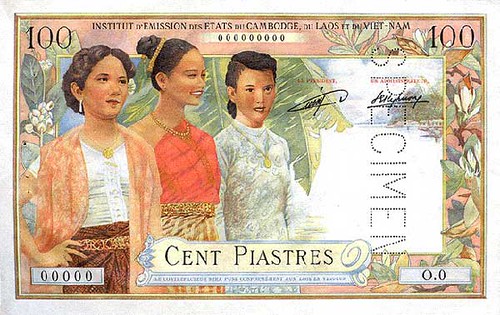
english.vietnamnet.vn/fms/society/113080/vietnamese-dong-through-history.html
